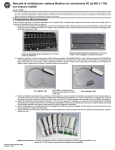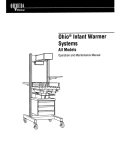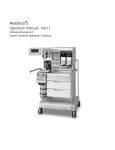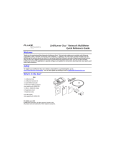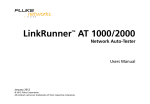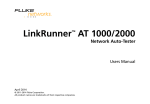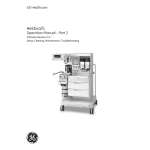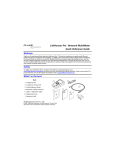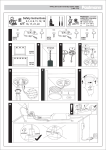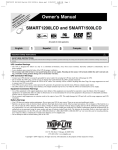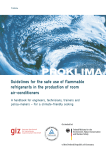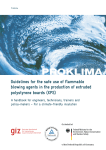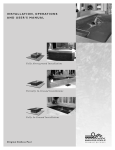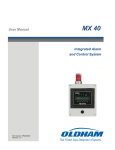Download Operation And Maintenance Manual
Transcript
Panda™ Baby Warmer Operation and Maintenance Manual Approved 2009−6−4 16:13 EET DST 6600−0371−000−DWG 100 Reproduced from the electronic master in MATRIX Barbara A Hairfield MANUAL−DOC, User Reference Manual, OM Panda, English−default TableResponsibility User of Contents This Product will perform in conformity with the description thereof contained in this operating manual and accompanying labels and/or inserts, when assembled, operated, maintained and repaired in accordance with the instructions provided. This Product must be checked periodically. A defective Product should not be used. Parts that are broken, missing, plainly worn, distorted or contaminated should be replaced immediately. Should such repair or replacement become necessary, Ohmeda Medical recommends that a telephone or written request for service advice be made to the nearest Ohmeda Medical Regional Service Center. This Product or any of its parts should not be repaired other than in accordance with written instructions provided by Ohmeda Medical and by Ohmeda Medical trained personnel. The Product must not be altered without the prior written approval of Ohmeda Medical’s Quality Assurance Department. The user of this Product shall have the sole responsibility for any malfunction which results from improper use, faulty maintenance, improper repair, damage, or alteration by anyone other than Ohmeda Medical. w i 6600−0371−000−DWG CAUTION: U.S. Federal law restricts this device to sale by or on the order of a licensed medical practitioner. 6600-0371-000 100 Reproduced from the electronic master in MATRIX 10/27/03 MANUAL−DOC, User Reference Manual, OM Panda, English−default i Table of Contents Definitions ....................................................................................................................... ii General Precautions ..................................................................................................... iv Warnings ........................................................................................................ iv Cautions ......................................................................................................... iv 1/Description 1.1 General ................................................................................................ 1-1 1.2 Support Structure ................................................................................. 1-1 1.3 Heater Assembly ................................................................................. 1-1 1.4 Control Unit .......................................................................................... 1-1 1.5 Bed Platform ........................................................................................ 1-2 1.6 Bassinet .............................................................................................. 1-2 1.7 Accessories ......................................................................................... 1-2 2/Setup and Checkout Procedure 2.1 Setup ................................................................................................... 2-1 2.2 Mechanical Checkout Procedure ......................................................... 2-1 A. Overall Appearance ..................................................................... 2-1 B. Heater Assembly Rotation .......................................................... 2-2 C. Mechanical Checks ..................................................................... 2-2 D. Accessory Checks ...................................................................... 2-3 E. Wall Mount Checkout .................................................................. 2-3 2.3 Control Unit Checkout Procedure ......................................................... 2-4 A. Control Unit Check ...................................................................... 2-4 B. Elapsed Timer Check .................................................................. 2-5 C. Observation Light Check ............................................................. 2-5 D. Raise and Lower Bed Switch Check ............................................ 2-5 E. Interlock Switch Check ................................................................ 2-6 F Power Failure, Memory and Battery Test .................................... 2-6 3.1 Control Panel Operation ....................................................................... 3-1 A. Displays ...................................................................................... 3-1 B. Indicator Lights ............................................................................ 3-2 C. Switches ..................................................................................... 3-2 D. Alarms ........................................................................................ 3-4 3.2 Preheat, Manual and Servo Mode Operation ........................................ 3-7 3.3 Elapsed Timer Operation .................................................................... 3-11 3.4 Bed Platform Operation ...................................................................... 3-11 3.5 Side Panel Operation ......................................................................... 3-12 3.6 Oxygen Administration ....................................................................... 3-13 3.7 Gas Cylinder Installation and Operation ............................................. 3-14 3.8 Mounting Accessories ....................................................................... 3-16 3/Operation i 6600−0371−000−DWG 6600-0371-000 100 Reproduced from the electronic master in MATRIX 10/27/03 MANUAL−DOC, User Reference Manual, OM Panda, English−default i Table of Contents A. B. 3.8 Mounting and Releasing Procedure ........................................ 3-17 Adapter Plate Mounting and Releasing Procedure ................. 3-17 Rotating Drawer Option .................................................................... 3-18 4/Cleaning and Disinfecting 4.1 Cleaning ............................................................................................. 4-1 4.2 Wood Surfaces ................................................................................... 4-2 4.3 Reusable Skin Temperature Probe .................................................... 4-2 5.1 Repair Policy and Procedure ............................................................. 5-1 5.2 Circuit Breaker Reset ......................................................................... 5-2 5.3 Lamp Replacement ............................................................................ 5-2 A. Alarm Lamp Replacement ......................................................... 5-2 B. Observation Lamp Replacement ............................................... 5-3 5.4 Yoke Manifold Assembly .................................................................... 5-5 5.5 Battery Test ........................................................................................ 5-5 5.6 Maintenance Schedule ....................................................................... 5-6 A. Operator Maintenance ............................................................... 5-6 B. Service Maintenance ................................................................. 5-6 5/Maintenance 6/Illustrated Parts Appendix Temperature Conversion Chart .................................................................. A-1 Servo Mode Algorithm ................................................................................ A-2 Infant Warmer System Specifications ......................................................... A-2 Electrical ............................................................................................. A-2 Controller ............................................................................................ A-3 Alarms ................................................................................................ A-4 Environmental Specifications ............................................................. A-5 Electromagnetic Compatibility (EMC) ................................................ A-6 Mechanical (Without Accessories) ..................................................... A-6 Bassinet ............................................................................................. A-6 Accessories ........................................................................................ A-7 Radiant Energy Distribution ............................................................... A-8 Installing wall mounted units ....................................................................... A-9 Pre-Installation Preparation .............................................................. A-10 Warmer Installation .......................................................................... A-10 Warranty ii 6600−0371−000−DWG 6600-0371-000 100 Reproduced from the electronic master in MATRIX 10/27/03 MANUAL−DOC, User Reference Manual, OM Panda, English−default ii Definitions Table of Contents Note: A Note provides additional information to clarify a point in the text. Important: An Important statement is similar to a note but used for greater emphasis. w w CAUTION: A Caution statement is used when the possibility of damage to the equipment exists. WARNING: A Warning statement is used when the possibility of injury to the patient or the operator exists. Symbols w m y y M ? Attention! Consult the manual for more information. Type B equipment. Functional Earth Terminal Protection Earth Terminal Increase % Power or Control Temperature Decrease % Power or Control Temperature Alarm Silence ~ Alternating Current Do not place an infant on this surface European Union Representative iii 6600−0371−000−DWG 6600-0371-000 100 Reproduced from the electronic master in MATRIX 10/27/03 MANUAL−DOC, User Reference Manual, OM Panda, English−default iii Notes Table of Contents iv 6600−0371−000−DWG 6600-0371-000 100 Reproduced from the electronic master in MATRIX 10/27/03 MANUAL−DOC, User Reference Manual, OM Panda, English−default iv General Table of Precautions Contents wWarnings Before using the Ohmeda Medical PandaTM Baby Warmer System, read this entire manual. Attempting to use this device without a thorough understanding of its operation may result in patient or user injury. This device should only be operated by personnel trained in its operation and under the direction of qualified medical personnel familiar with the risks and benefits of this type of device. Additional precautions specific to certain procedures are found in the text of this manual. Do not use the Warmer in the presence of flammable anesthetics; a possible explosion hazard exists under these conditions. Do not perform the Checkout Procedures (Mechanical and Control Unit) while a patient occupies the Warmer. Complete the “Checkout Procedures” section of this manual before putting the unit into operation. If the warmer fails any portion of the checkout procedures it must be removed from use and repaired. Do not use the Warmer system if the system failure alarm is activated. Remove the unit from service and refer to qualified personnel for repair. wCautions Only competent individuals trained in the repair of this equipment should attempt to service it as detailed in the service manual. The Service Manual provides detailed information solely for use by individuals having proper knowledge, tools and test equipment, and for service representatives trained by Ohmeda Medical. v 6600−0371−000−DWG 6600-0371-000 100 Reproduced from the electronic master in MATRIX 10/27/03 MANUAL−DOC, User Reference Manual, OM Panda, English−default v Notes Table of Contents vi 6600−0371−000−DWG 6600-0371-000 100 Reproduced from the electronic master in MATRIX 10/27/03 MANUAL−DOC, User Reference Manual, OM Panda, English−default vi 1/Description In this section 1.1 General ................................................................................................................ 1-1 1.2 Support Structure ................................................................................................. 1-1 1.3 Heater Assembly ................................................................................................. 1-1 1.4 Control Unit .......................................................................................................... 1-1 1.5 Bed Platform ........................................................................................................ 1-2 1.6 Bassinet .............................................................................................................. 1-2 1.7 Accessories ......................................................................................................... 1-2 1.1 General The Ohmeda Medical PandaTM Baby Warmer provides a controlled source of radiant heat for infants and pediatric patients. The control system uses a microprocessor and provides both manual and servo modes of operation. The patient temperature, control temperature, and elapsed time displays are digital for ease of viewing. The control panel includes a one hour elapsed timer with time displayed in minutes and seconds. The timer features optional audible tones for use during Apgar scoring. A complete audio and visual alarm system is included on the control panel. 1.2 Support Structure The support structure provides excellent stability for the radiant heater and optional accessories. On the free standing unit, the support structure consists of the base assembly and the uprights with an integral rail system. The rails provide a means for mounting accessories and ancillary equipment to the unit. Refer to Section 1.7 for a description of the accessory items. 1.3 Heater Assembly The warmer is designed to warm infants on a bed surface located beneath the heater assembly. WARNING: w Bed-to-heater spacing less than the recommended 64 cm will result in incorrect operation and may adversly affect the patient’s condition. For your convenience, on the free standing unit the proper bed-to-heater spacing is indicated by a label located on the right aluminum upright (as viewed from the front). The heater assembly consists of a radiant heater, parabolic reflector, observation light, and a visual alarm light. The parabolic reflector focuses radiant energy on the bed surface, minimizing energy loss due to scattering and providing an even field of radiant heat over the bed surface. The observation light provides intense light for procedures. The alarm light is located on the end of the heater assembly for ease of viewing. The entire heater assembly rotates to the side for X-ray procedures and for observation lamp replacement. 1.4 Control Unit The control unit contains the electronic circuits and controls used to operate the radiant heater and the observation light. The control unit performs regular self checks during its operation including failure diagnostics. 1-1 6600−0371−000−DWG 6600-0371-000 100 Reproduced from the electronic master in MATRIX 10/27/03 MANUAL−DOC, User Reference Manual, OM Panda, English−default 1-1 1/Description When the unit is first turned on, it automatically operates in the preheat mode, and will continue to do so until the mode, increase/decrease or Apgar buttons are pressed. Then a tone will prompt the operator to select a heater power percentage in the manual mode. Either manual or servo mode of operation may be selected. In the manual mode of operation, select the level of radiant heat output as indicated by the % power display on the control panel. The control circuit then maintains the selected level of radiant heat. In the servo mode of operation, select the patient’s control temperature. A skin temperature probe is used to monitor the patient skin temperature. The control system modulates the radiant heat to maintain the patient at the selected control temperature. The patient’s skin temperature is continuously displayed. Alarms activate to alert the operator of a low or high patient temperature, a skin temperature probe failure, a power failure, equipment failure or a check patient prompt. 1.5 Bed Platform The warmer with a bed includes a mattress and transparent side panels. The side panels fold down for easy access to the patient and can be removed for cleaning. The tiltable bed platform allows Trendelenburg and reverse Trendelenburg positioning. The hydraulic system for the tiltable bed provides a smooth, dampened motion to avoid disturbing the patient. 1.6 Bassinet Two bassinets models are available for use with the free standing warmers. One with removabe drop side panels and mattress, and one with a removable tub. Transparent locking side panels fold down for easy patient access and are removable for cleaning. A tiltable lock block allows Trendelenburg and reverse Trendelenburg positioning at the 8° tilt position. Three drawers open from the side for storing equipment or supplies. The top drawer is provided with a key lock. Front casters lock to hold the bassinet in place. 1.7 Accessories The rail mounting system is the basis for most of the accessories for the Warmer. This patented design consists of a dovetail shaped aluminum extrusion and a positive locking mounting block. Mounting blocks are attached to various accessories for mounting to the rail system. The mounting blocks are produced in two standard lengths and are machined to accommodate each specific accessory. Accessories which mount on a single upright are interchangeable between all model Warmers. Accessories can only be mounted to the inside dovetail rail on each upright of the free standing warmer. 1-2 6600−0371−000−DWG 6600-0371-000 100 Reproduced from the electronic master in MATRIX 10/27/03 MANUAL−DOC, User Reference Manual, OM Panda, English−default 1-2 2/Setup and Checkout Procedures In this section 2.1 Setup ................................................................................................................... 2-1 2.2 Mechanical Checkout Procedure ......................................................................... 2-1 A. Overall Appearance ......................................................................................... 2-1 B. Heater Assembly Rotation .............................................................................. 2-2 C. Mechanical Checks ........................................................................................ 2-2 D. Accessory Checks ......................................................................................... 2-2 E. Wall Mount checkout ...................................................................................... 2-3 2.3 Control Unit Checkout Procedure ......................................................................... 2-4 A. Control Unit Check ......................................................................................... 2-4 B. Elapsed Timer Check ..................................................................................... 2-4 C. Observation Light Check ................................................................................. 2-5 D. Raise and Lower Bed Switch Check ............................................................... 2-5 D. Interlock Switch Check ................................................................................... 2-6 E. Power Failure, Memory and Battery Test ........................................................ 2-6 2.1 Setup Refer to the setup instructions shipped with the warmer for initial unpacking and setup of the unit after shipment. After removal from the shipping containers, inspect the Ohmeda Panda Baby Warmer and all accessory items for any signs of damage which may have occurred during shipment. File a damage claim with the shipping carrier if damage has occurred. Also confirm the presence of all accessory items or factory installed options as listed on the packing slip. 2.2 Mechanical Checkout Procedure WARNING: w Before using the Ohmeda Panda Baby Warmer, read this entire manual. Attempting to use this device without a thorough understanding of its operation may result in patient or user injury. w Do not perform the Checkout Procedures (Mechanical and Control Unit) while a patient occupies the warmer. w Complete the “Checkout Procedures” section of this manual before putting the unit into operation. If the warmer fails any portion of the checkout procedures it must be removed from use and repaired. A. Overall Appearance 1. Disconnect the power cord from the ac power source for the mechanical checks portion of this procedure. 2. Check the overall appearance of the Panda Baby Warmer/ Bassinet System. There should be no obvious damage. 3. Check that all casters are in firm contact with the floor and that the warmer is stable and moves freely. For the free standing warmer, check that all six casters on the warmer move freely. Note: On the free steanding warmer, it is possible that the two center casters may not be in contact with the floor at all times. 2-1 6600−0371−000−DWG 6600-0371-000 100 Reproduced from the electronic master in MATRIX 10/27/03 MANUAL−DOC, User Reference Manual, OM Panda, English−default 2-1 2/Setup and Checkout Procedures 4. Lock the two front casters and check that the warmer is held in place. On the free standing warmer, lock the two rear casters and check that the warmer is held in place. 5. For the free standing warmer, place the bassinet on a level surface. Check that all four casters are in firm contact with the floor and that the bassinet moves freely. 6. Examine the power cord for damage. Replace the power cord if damage is evident. 7. Examine the unit for objects placed on top of the heater assembly. 8. WARNING: Check heater-to-bed spacing falls within ranges specified in "1.3 Heater Assembly". w Do not place any accessories or other objects directly over the bed surface. This may block radiant heat energy and lead to cooling of the infant. w Do not place items on top of the heater assembly. Items placed on top of the heater assembly can fall and injure the patient, prevent adequate ventilation of the heater assembly, and may pose a fire hazard. B. Heater Assembly Rotation Rotate the Heater Assembly to the side and then back to the normal position. Check for a smooth rotation. C. Mechanical Checks 1. Check the operation of the bed sides. The bed sides should operate smoothly. WARNING: w Regularly inspect the bed side panel latching mechanism to ensure proper operation and to prevent the infant falling off the bed. 2. Check the operation of the tilt mechanism. Verify that the bed platform operates smoothly and locks in normal, Trendelenburg and reverse Trendelenburg positions. 3. If the drawer package is installed, check that all the drawers open and close freely. On units with the rotating drawer package, make sure the drawers rotate from front to 90° left and right and firmly stop in the detented positions. WARNING: w Overloading the drawers can affect the stability of the unit. Limit the load to 4.6 kg per drawer. D. Accessory Checks Perform these checks if they are applicable. 1. Check that all accessories are mounted securely and that the load limits are not exceeded. 2. Check that all gas accessories are installed and operating properly (refer to Section 3.9). 3. Where applicable, perform the checkout procedures detailed in the Operation and Maintenance Manuals for the accessories. 2-2 6600−0371−000−DWG 6600-0371-000 100 Reproduced from the electronic master in MATRIX 10/27/03 MANUAL−DOC, User Reference Manual, OM Panda, English−default 2-2 2/Setup and Checkout Procedures WARNING: w Limit the load of accessories to 23 kg per side on the Warmer to ensure stability. Always try to evenly distribute the weight of accessories on both sides of the unit for a more balanced load. Accessories should not be mounted more than 142 cm above the floor. For free standing warmers, limit the load of accessories to 9 kg maximum per side mounted no more than 112 cm above the floor. CI.14.096 E. Wall Mount Checkout Figure 2-1 Wall mount pin insertion 1. Verify that the warmer is rigidly secured to the wall and the heater assembly is level. Note: To access the control unit and display module for service procedures, either hinge pin may be removed, allowing the warmer to pivot away from the wall. 2. Check that both hinge pins are in place and fully inserted with the pin heads at the top of the hinge. WARNING: w In the service position the strength of the hinge bracket is reduced. Never place a patient in the bed when the heater is in the service position. Never leave the unit unattended in the service position or with either pin removed. Light On/Off Switch 0000 Control Temperature Heater Power % 0000 Elapsed Time Display CI.44.005 Patient Temperature 0000 Bed Controls* Alarm Lights * Alarm Silence Mode Switch Mode Indicators Increase Decrease Apgar Indicator Apgar Tones On/Off Elapsed Time Start/Hold and Reset Bed controls present on elevating bed models only. Figure 2-2 Control Panel 2-3 6600−0371−000−DWG 6600-0371-000 100 Reproduced from the electronic master in MATRIX 10/27/03 MANUAL−DOC, User Reference Manual, OM Panda, English−default 2-3 2/Setup and Checkout Procedures 2.3 Control Unit Checkout Procedure WARNING: w Do not perform the Checkout Procedures (Mechanical and Control Unit) while a patient occupies the warmer. w Complete the “Checkout Procedures” section of this manual before putting the unit into operation. If the warmer fails any portion of the checkout procedures it must be removed from use and repaired. A. Control Unit Check 1. Connect the warmer power cord to an appropriate power source. Refer to the rating plate on the Warmer for the proper voltage needed. Switch the power On and verify the following on the Control Panel (Figure 2-2): a. The alternating two tone audible alarm sounds and all displays and indicators are lit for approximately two seconds. Note: During this time the controller also performs self check functions. If the controller detects a failure, the alarm stays on and service is required. Note: All alarms except system failure or power failure are preceded by a 30 second intermittent operator prompt tone. b. The display flashes "PrE HEAT" until the mode, increase/decrease or Apgar touch switches are pressed. Press the decrease touch switch. c. The manual mode indicator is lit. d. Operator prompt tones sound and the % power display flashes. 2. Adjust the heat output with the increase (M) and decrease (?) touch switches to attain the high and low limits as indicated by the % power display. 3. Connect the skin temperature probe to the warmer. 4. Press the mode touch switch to place the warmer in the servo mode and verify the following: a. The servo mode indicator is lit. b. An operator prompt tone sounds and the control temperature display flashes 36.5°C. 5. Press the increase (M) touch switch and verify that the maximum servo control temperature attainable is 37.5°C. Note: A patient temperature alarm occurs if the difference between the patient temperature and the control temperature is greater than 1°C (the difference can be adjusted to 0.5°C by a qualified service person). Note: An alternating two tone alarm, a flashing overhead alarm light and a flashing patient temperature display may occur here if the skin temperature probe is below 30°C. Warm the probe with your fingers or silence the alarm. 6. Press the decrease touch switch and verify that the minimum servo control temperature attainable is 35.0°C. 7. Disconnect the skin temperature probe. Verify the following: a. The probe failure indicator light is lit. b. There is an alternating two tone alarm. c. The overhead alarm light is flashing. 2-4 6600−0371−000−DWG 6600-0371-000 100 Reproduced from the electronic master in MATRIX 10/27/03 MANUAL−DOC, User Reference Manual, OM Panda, English−default 2-4 2/Setup and Checkout Procedures d. The patient temperature display flashes “HH.H”. Note: The functionality of the remainder of the alarms is continually checked by the microprocessor software during normal operation. If a fault occurs in any of this circuitry, an indicator lights and a tone is sounded. The patient alarm can be verified manually by placing the unit in the manual mode and setting the power to 50%. After 12 minutes, the patient alarm should sound. Additionally, a computer independent ”watchdog“ circuit will reset the computer, turn off the heater, and activate the alarms in the event of a microprocessor failure or software failure. 8. Press the alarm silence touch switch and verify the following: a. The probe failure indicator light is lit. b. The alternating two tone alarm is silenced. c. The overhead alarm light is lit. d. The patient temperature display indicates “HH.H”. e. After one minute, the alternating two tone alarm sounds, the overhead alarm flashes and the patient temperature display flashes “HH.H”. 9. Switch to the manual mode and set the heat at 25% power. B. Elapsed Timer Check 1. Press the Start/Hold touch switch to activate the elapsed timer. Verify that the timer starts operating. 2. Press the Apgar tones On/Off touch switch for the Apgar tones. Verify that the indicator light for the Apgar tones is extinguished. 3. Press the Apgar tones On/Off switch for the Apgar tones again. Verify that the indicator light for the Apgar tones is lit. 4. Press the Start/Hold touch switch. Verify that the present elapsed time is held. 5. Press the Start/Hold touch switch and verify that the timer updates to the current elapsed time and the Apgar tones continue to sound at the specified times (at 1 minute and at every 5 minute interval after the elapsed timer has started). 6. Press the Reset touch switch and verify that the timer indicates “00:00”. If the elapsed timer is not used for approximately two minutes, the display switches off. C. Observation Light Check Press the Light On/Off touch switch. Verify that the observation light functions. D. Raise and Lower Bed Switch Check (Elevating Models Only) CAUTION: w Do not continue to run the motor at the upper and lower limit positions; equipment damage may result. 1. Press the Raise Bed touch switch and verify that the bed raises to a maximum of 118 cm off the floor. 2-5 6600−0371−000−DWG 6600-0371-000 6600-0371-000 100 Reproduced from the electronic master in MATRIX 10/27/03 03/07/02 MANUAL−DOC, User Reference Manual, OM Panda, English−default 2-5 2/Setup and Checkout Procedures 2. Press the Lower Bed touch switch and verify that the bed lowers to a minimum of 98 cm off the floor. 3. Press the foot switches on both sides of the unit and verify that they raise and lower the bed. E. Interlock Switch Check 1. Place the warmer in the manual mode at 25% power output. 2. Rotate the heater assembly to the side. Verify that the heat off indicator light is On and the % power display indicates 0% heat. 3. Rotate the heater assembly to the normal operating position. Verify that the heat off indicator light is Off and the % power display indicates 25%. F. Power Failure, Memory and Battery Test 1. Operate the unit in the manual mode with the heat set at 25% power for a minimum of one hour to charge the battery. Note: The battery must be fully charged to pass the 10 minutes test or partially charged to pass the two minute test. If the battery is defective, replace it. Refer to the service manual. There is no maintenance required for the battery. The battery has a two year replacement schedule. 2. Remove the Warmer power plug from the power source for two minutes. Do not switch the power Off. The power failure alarm should sound for two minutes and the power failure indicator on the display panel lights. Note: If the power failure alarm is tested for 10 minutes, the warmer must be connected to the correct power source and operated for 24 hours to recharge the battery before allowing a patient to occupy the Warmer. Note: The power failure alarm will not operate if the circuit breaker trips. 3. Reconnect the warmer to the power source. Verify the following: a. The warmer is operating in the manual mode. b. The heat output is still set at 25% power. c. The audio power failure alarm is off. 2-6 6600−0371−000−DWG 6600-0371-000 100 Reproduced from the electronic master in MATRIX 10/27/03 03/07/02 MANUAL−DOC, User Reference Manual, OM Panda, English−default 2-6 3/Operation In this section 3.1 Control Panel Operation ....................................................................................... 3-1 A. Displays ......................................................................................................... 3-1 B. Indicator Lights ............................................................................................... 3-2 C. Switches ........................................................................................................ 3-2 D. Alarms ............................................................................................................ 3-4 3.2 Preheat, Manual and Servo Mode Operation 3.3 Elapsed Timer Operation .................................................................................... 3-11 3.4 Bed Platform Operation ...................................................................................... 3-11 3.5 Side Panel Operation ......................................................................................... 3-12 3.6 Oxygen Administration ....................................................................................... 3-13 3.7 Gas Cylinder Installation and Operation ............................................................. 3-14 3.8 Mounting Accessories ....................................................................................... 3-16 A. Mounting and Releasing Procedure .............................................................. 3-17 B. Adapter Plate Mounting and Releasing Procedure ........................................ 3-17 3.9 Rotating Drawer Option ...................................................................................... 3-18 ..................................................... 3-7 3.1 Control Panel Operation (Control Panel is shown in Figure 2-2) A. Displays • Patient Temperature • Control Temperature* • % Power • Elapsed Time* *During the preheat mode "PrE HEAT" flashes in the control temperature and elapsed time displays. Patient Temperature: The patient temperature display indicates the temperature sensed at the skin temperature probe tip. The skin temperature probe must be properly connected to the warmer and the infant for an accurate patient temperature measurement. The range of temperature measurement is from 30.0 to 42.0°C, with a resolution of 0.1°C. Temperatures above this range result in an “HH.H” patient temperature display and below this range result in an “LL.L” patient temperature display . Control Temperature: The control temperature display indicates the control temperature you select in the servo mode. The servo control temperature range is from 35.0 to 37.5°C. The control temperature display is not active in the manual mode. % Power: The % power display indicates the percentage of maximum power that is being supplied to the radiant heater in 5% increments. Power settings between 0 to 25% allow operation without the 12 minute check patient alarm in the manual mode. 3-1 6600−0371−000−DWG 6600-0371-000 100 Reproduced from the electronic master in MATRIX 10/27/03 MANUAL−DOC, User Reference Manual, OM Panda, English−default 3-1 3/Operation Elapsed Time: The elapsed time display indicates elapsed time in minutes and seconds up to a maximum of 60 minutes. B. Indicator Lights • Servo Mode Indicator • Manual Mode Indicator • Apgar Tones Indicator Servo Mode Indicator: The servo mode indicator lights when the warmer is in the servo mode of operation. For proper operation of the warmer in the Servo Mode see section 3.2. Manual Mode Indicator: The manual mode indicator lights when the warmer is in the manual mode of operation. For proper operation of the warmer in the Manual Mode see section 3.2. WARNING: w Use the servo mode unless the manual mode is specifically prescribed. While both modes require patient monitoring, the manual mode requires constant attention. In the manual mode, you must take the responsibility for making heater adjustments or environmental changes in response to the following conditions: • patient size and weight; • bed to heater head height differences; • changes in the environment (drafts, direct sunlight, phototherapy lamp usage, etc.); • changes in the patient condition In the servo mode, the warmer automatically adjusts heater output to maintain the desired skin temperature, reducing (but not eliminating) the need to monitor the patient and make environmental adjustments to ensure adequate patient temperature. Apgar Tones Indicator: The Apgar tones indicator lights when the Apgar tones are activated, and the Apgar timer is running. C. Switches • Mode Switch • Increase (M) and Decrease (?) Switches • Alarm Silence • Start/Hold • Reset • Apgar Tones On/Off • Light On/OffMode Switch • Raise Bed (M) (Elevating models only) • Lower Bed (?) (Elevating models only) 3-2 6600−0371−000−DWG 6600-0371-000 100 Reproduced from the electronic master in MATRIX 10/27/03 MANUAL−DOC, User Reference Manual, OM Panda, English−default 3-2 3/Operation This switch is used to select either the Manual or Servo mode of operation. An audio tone sounds momentarily when the mode switch is depressed. ?) Switches: Increase (M M) and Decrease (? These switches are used to set the radiant power level (% power) in the manual mode and to set the control temperature in the servo mode. Alarm Silence: This switch is used to silence the audible alarm. It silences all alarms except the system failure alarm. Refer to Table 1 - Warmer Alarms for details on how long the audible alarms are silenced. Holding this switch depressed for five seconds or longer activates the audible alarm and lights all the indicator lamps for testing purposes. Start/Hold: This switch activates the elapsed timer. Refer to the elapsed timer operation, Section 3.3, for a detailed explanation of its function. Reset: This switch is used to reset the elapsed timer to “00:00”. Apgar Tones On/Off: This switch activates the Apgar tones. When the Apgar tones are activated, a short alarm tone is sounded at one minute and every five minute interval after the elapsed timer is started. Light On/Off: This switch activates the observation light located in the heater assembly. WARNING: w Prolonged exposure to the light emitted by the observation lamp in this unit may harm the unprotected eyes of the infant. For safety, cover the infant’s eyes. M) (Elevating Models Only) Raise Bed (M WARNING: w Check for proper clearance above the Warmer and below the bed surface before raising or lowering the bed. w Inspect all patient connected tubes or wires before and after moving or tilting the bed. Tilting or moving the warmer bed up or down can pull on tubing or leads connected to the patient. This may disconnect tubes or leads, restrict gas or liquid flow, or move sensors out of position. CAUTION: w Do not continue to run the motor at the upper and lower limit positions; equipment damage may result. This switch raises the bed to a maximum height of 118 cm from the floor. Lower Bed (? ?) (Elevating Models Only) This switch lowers the bed to a minimum height of 98 cm from the floor. 3-3 6600−0371−000−DWG 6600-0371-000 100 Reproduced from the electronic master in MATRIX 10/27/03 MANUAL−DOC, User Reference Manual, OM Panda, English−default 3-3 3/Operation On/Off Power Switch and Circuit Breaker: (See Figure 3-1.) The On/Off power switch is located on the left side of the controller assembly (as viewed from the front) near the power cord socket. It is used for switching the power to the warmer(On and Off). The switch is also a circuit breaker and limits the maximum current drawn by the unit. If this circuit breaker trips when the warmer is operating, the power switch is deactivated to the Off position. To reset the circuit breaker, return the power switch to the On position. If the circuit breaker trips again, service is required. On/Off Switch CI.05.009 (I-On, O-Off) Figure 3-1 On/Off Power Switch with built-in circuit breaker D. Alarms All alarms except system failure and power failure are preceded by a 30 second intermittent operator prompt tone. • • • • • Probe Failure Alarm Patient Temperature Alarm System Failure Alarm Heat Off Alarm Check Patient Alarm • Power Failure Alarm Probe Failure Alarm: The probe failure alarm is only active in the servo mode of operation. The alarm activates when the skin temperature probe fails electrically due to an open or short circuit, or is disconnected from the Warmer. The heater deactivates and the patient temperature display flashes “HH.H” or “LL.L” when this alarm condition exists. Patient Temperature Alarm: The patient temperature alarm is only active in the servo mode of operation. The alarm activates when the difference between the patient temperature and the control temperature is greater than 1°C. When the patient temperature returns to within 0.8°C of the control temperature, this alarm is automatically reset. Note: If the patient temperature probe reads below 30°C or above 42°C in servo mode, the heater is deactivated and “LL.L” or “HH.H” respectively, appears in the patient temperature display. Note: Qualified service personnel can adjust the alarm to trigger at a difference of 0.5°C and reset at a difference of 0.3°C. 3-4 6600−0371−000−DWG 6600-0371-000 100 Reproduced from the electronic master in MATRIX 10/27/03 MANUAL−DOC, User Reference Manual, OM Panda, English−default 3-4 3/Operation WARNING: w In the servo mode, verify that the patient temperature probe is securely attached to the patient at least once every half hour. A dislodged probe may not trigger an alarm. If the probe becomes dislodged, the warmer can over or under heat the infant. w The skin temperature probe should be located on the patient’s skin in an area which is directly in the path of the radiant heat. It should not be attached to an area which is shielded from the radiant heat or between the patient and the mattress. Large temperature gradients and very long servo response times will result from improper probe placement. w Rectal temperatures must never be used to servo control a patient’s temperature. System Failure Alarm: The system failure alarm activates if the solid state relay controlling the radiant heater fails, if the microprocessor fails or if the calibration drifts by more than 0.3°C. The alternating two tone alarm cannot be silenced with the alarm silence switch. WARNING: w Do not use the Warmer system if the system failure alarm is activated. Remove the unit from service and refer to qualified personnel for repair. Heat Off Alarm: When the heater is rotated to the side position, the heater is switched off and the Heat Off indicator is switched on. The audible Heat Off alarm activates after 5 minutes if the heater is not returned to the normal position. The alarm can be silenced by pressing the Alarm Silence switch. Check Patient Alarm: 1. Preheat Mode: Check patient alarm is inactivated in this mode. 2. Manual Mode: The check patient alarm activates in the manual mode of operation when the heater has been energized at a power level greater than 25% for 12 minutes. The alternating single tone alarm is activated for this condition. Pressing the alarm silence switch silences this alarm and resets the timer for another 12 minutes of operation. If this alarm is not silenced within 3 minutes of the check patient alarm occurring, an alternating two tone alarm is sounded and the heater is deactivated until the alarm silence switch is pressed. 3. Servo Mode: The check patient alarm activates in the servo mode of operation if the heater has been at the 100% power level for 12 continuous minutes. The alternating single tone alarm is activated for this alarm. Pressing the alarm silence switch silences this alarm and resets the timer for another 12 minutes of operation. If this alarm is not silenced within 3 minutes of the check patient alarm occurring, the alternating two tone alarm is sounded and the heater is deactivated until the alarm silence switch is pressed. Power Failure Alarm: A battery operated power failure alarm activates when the external power source fails or is accidentally disconnected. The battery also provides power to an electronic memory to recall previous control temperature settings for approximately 10 minutes, when the battery is fully charged. 3-5 6600−0371−000−DWG 6600-0371-000 100 Reproduced from the electronic master in MATRIX 10/27/03 MANUAL−DOC, User Reference Manual, OM Panda, English−default 3-5 3/Operation Table 1 — Warmer Alarms Alarm Condition Probe Failure‡ Alarm Sound Alternating Two-Tone † Alarm Silence Period 1 minute Heater Off Patient Temperature is greater than 42°C‡ Alternating Two-Tone † 1 minute Off Patient Temperature more than 2°C from Control temperature‡ Alternating Single-Tone † 5 minutes * Patient Temperature between 1 and 2°C §of Control temperature‡ Alternating Single Tone † 15 minutes * Patient Temperature is less than 30°C ‡ Alternating Two-Tone † 1 minute Off System Failure** Alternating Two-Tone Cannot be silenced Off Heat Off Alternating Single Tone † 5 minutes Off Check Patient Alternating Single Tone † after 12 minutes Alternating Two-Tone after 15 minutes 12 minutes * 15 minutes Off Cannot be silenced Off Power Failure Alternating Single Tone * Heater output is dependent on the Patient Temperature and Control Temperature settings in the servo mode, and the % Power setting in the manual mode. ** Error code in elapsed time display indicates the cause of the alarm. † Preceded by a 30 second operator prompt tone. § Can be set to between .5 and 2°C by qualified service personnel. Error Codes: In the event of a system failure, a nonsilenceable, high priority alarm sounds and the System failure LED illuminates. Before shutting off the Warmer and removing it from service, make note of the error code that appears in the elapsed time display. This code will aid qualified service personnel in diagnosing the problem. Table 2 lists the possible error codes, for a more detailed explanation of error codes see the Service manual. Table 2— Warmer Error Codes E001 Instruction Test Failure E002 ADC High Calibration Failure E003 ADC Low Calibration Failure E004 Checksum Failure E005 RAM Test Failure E007 ADC Converter Failure E010 Line Voltage Out of Range E012 Heater Not Switching On E013 Heater Not Switching Off E014 Alarm Oscillator Failure E015 Software Upset - RAM Inconsistency E016 Safety Relay Not Opening Properly E017 Software Upset - Missing Routine E019 Software Upset E025 Hardware Watchdog Circuit Tripped 3-6 6600−0371−000−DWG 6600-0371-000 100 Reproduced from the electronic master in MATRIX 10/27/03 MANUAL−DOC, User Reference Manual, OM Panda, English−default 3-6 3/Operation 3.2 Preheat, Manual and Servo Mode Operation WARNING: w Before using the Panda Baby Warmer System, read this entire manual. Attempting to use this device without a thorough understanding of its operation may result in patient or user injury. This device should only be operated by personnel trained in its operation and under the direction of qualified medical personnel familiar with the benefits and risks of this type of device. w Do not leave the patient unattended when using the Infant Warmer. Check the patient’s temperature periodically using an independent temperature monitoring device to ensure the comfort and the safety of the patient. If the warmer is used for an extended time, it is recommended that the servo mode of operation be used. When an alarm is silenced, close monitoring of the patient’s condition is required. w Use of electrosurgical units or other electrical field radiating equipment can affect the operation of the Warmer. Keep the patient probe lead as far away as possible from electrosurgical cables. Do not allow excess electrical cables to be laid on the bed platform. Use of electrosurgical units or other instruments which radiate electrical fields can cause indirect heating, by several tenths of a degree of the skin temperature probe due to absorbed electrical energy. When using these devices near the radiant warmer, operate the Warmer in manual mode for maximum safety. w The use of phototherapy equipment may raise the patient’s temperature. w Radiant warmers increase an infant’s insensible water loss. Take appropriate measures to maintain the patient’s fluid balance while caring for them in a radiant warmer. w Do not use the Warmer in the presence of flammable anesthetics; a possible explosion hazard exists under these conditions. w Radiant energy can adversely affect blood components. When using intravenous tubing systems for delivery of blood components to patients occupying a warmer, shield any tubing with aluminum foil. w When using a radiant warmer, change the patient’s diapers frequently. Radiant energy causes more rapid urine evaporation, and may lead to inaccurate urine diagnosis test analysis and inaccurate weight measurements. w Do not touch the protective grill under the radiant heater or the top of the heater assembly. These surfaces may be hot and a burn could result. w Always set the caster brakes before placing a patient in the warmer. 1. Connect the power cord to a properly grounded AC power source. 2. Place the power switch in the On position. During the first seconds of operation, the warmer performs a self check of the control system. The software is verified, calibration is checked and operation of the solid state relay controlling the heater is verified. All displays and indicators are lit and the audible alarm is sounded. If the self check detects a failure, the alarm stays on and service is required. Note: The Panda Baby Warmer begins operation in the Preheat Mode, described in Step 3. To operate the warmer in the Manual Mode, refer to step 4. To operate the warmer in the Servo Mode, refer to Step 6. 3-7 6600−0371−000−DWG 6600-0371-000 100 Reproduced from the electronic master in MATRIX 10/27/03 MANUAL−DOC, User Reference Manual, OM Panda, English−default 3-7 3/Operation WARNING: w Do not operate the warmer in the preheat mode while a patient occupies the bed. The preheat mode is used to quickly warm and maintain heat to an empty bed. The preheat mode is not designed for clinical use with a patient since the Check Patient Alarm is disabled. 3. Preheat Mode Operation The Panda Baby Warmer automatically starts in the Preheat Mode. During the preheat mode Check Patient Alarms are not activated. In the Preheat Mode, the control temperature and elapsed time displays continiously flash the message "PrE HEAT" and the heater operates at 100% power for the first 12 minutes. After 12 minutes, heater power drops to 50%, and will continue at 50% until either the mode, increase/decrease or Apgar touch switches are pressed. Pressing the mode, increase/decrease or Apgar touch switches exits the Preheat Mode and returns the warmer to normal modes of operation. If the Apgar touch switches are pressed, the manual mode indicator will light and a prompt tone will sound until a power percentage is selected using the increase/decrease touch switches. The Check Patient Alarm is again activated. If the mode or the increase/decrease touch switches are pressed, the unit will automatically change to the Manual Mode with a power percentage setting of 50%. The Check Patient Alarm is again activated. The only way to re-enter the preheat mode is to shut off and restart the warmer. 4. Manual Mode Operation. WARNING: w Use the servo mode unless the manual mode is specifically prescribed. While both modes require patient monitoring, the manual mode requires constant attention. In the manual mode, you must take the responsibility for making heater adjustments or environmental changes in response to the following conditions: • patient size and weight; • bed to heater head height differences; • changes in the environment (drafts, direct sunlight, phototherapy lamp usage, etc.); • changes in the patient condition In the servo mode, the warmer automatically adjusts heater output to maintain the desired skin temperature, reducing (but not eliminating) the need to monitor the patient and make environmental adjustments to ensure adequate patient temperature. In the manual mode of operation, an operator prompt tone and the flashing of the % power display prompt you to select a level of radiant heat. Use the increase (M) or decrease (?) touch switch to adjust the % power in 5% increments. The % power display indicates the power level selected. You must select a % power level each time the warmer is switched to the manual mode. When you select % power levels between 30% and 100%, a check patient alarm sounds after 12 minutes to remind you to monitor the patient temperature. After checking the patient, this alarm can be reset by pressing the alarm silence switch. This alarm recurs every 12 minutes during operation in the manual mode. If the alarm silence switch is not pressed within 3 minutes of the check patient alarm, an alternating two tone alarm sounds and the heater is turned off. In the manual mode, the warmer may be operated using 0% to 25% power level settings without the 12 minute check patient alarm being activated. 3-8 6600−0371−000−DWG 6600-0371-000 100 Reproduced from the electronic master in MATRIX 10/27/03 MANUAL−DOC, User Reference Manual, OM Panda, English−default 3-8 3/Operation The skin temperature probe may be used to monitor the patient’s temperature in the manual mode but it does not control the radiant heat energy level. See step 5 for skin temperature probe attachment. Note: A patient placed in any warmer will normally develop temperature gradients with hotter and cooler areas. This is due to radiant heat being applied above the infant, the cooling effect from the mattress below the infant, the unequal skin cooling effect from evaporative water loss, unequal internal heat generation within the patient, and the environmental variables of room temperature, room air movement, incidental sunlight, etc. 5. Skin Temperature Probe Attachment. WARNING: w Use only the Reusable Ohmeda skin temperature probe (Stock No. 02080697-700) and heat reflective patches (Stock No. 0203-1980-300, 50/pkg) or the disposable probe (Stock No. 6600-0208-700, 10/pkg; Stock No. 66000196-700. 50/pkg) to monitor the patient’s skin temperature. Use of other manufacturer’s probes may affect the accuracy of warmer operation and the electrical safety of the patient. w The skin temperature probe should be located on the patient’s skin in an area which is directly in the path of the radiant heat. It should not be attached to an area which is shielded from the radiant heat or between the patient and the mattress. Large temperature gradients and very long servo response times will result from improper probe placement. w Rectal temperatures must never be used to servo control a patient’s temperature. The Ohmeda Patient probe lead is made from low mass wire that helps prevent probe detachment while reducing pulling on the neonate’s skin. Place the metal side of the skin temperature probe on the skin over the liver area of the infant’s abdomen. Remove the paper protecting the hypoallergenic adhesive on the Heat Reflective Patch. Secure the skin temperature probe to the patient’s skin with the adhesive side of the patch (Figure 3-2). Do not remove the heat reflecting foil which must be facing up. Note: The probe jack is attached at a specific torque value. Loosening or tightening the jack may break the electrical connector. See Figure 3-3. If the patient is prone, place the skin temperature probe on the back, where it will not be against the mattress. If the probe is between the patient and the mattress, it will produce false readings. WARNING: w Intimate contact between the skin temperature probe tip and the patient’s skin must be maintained for accurate skin temperature measurement. Underheating or overheating may result from poor contact between the skin temperature probe and the patient. Verify that the skin temperature probe is securely attached to the patient at least once every half hour. Connect the skin temperature probe to the Warmer by plugging the probe connector into the left side of the display module as viewed from the front. (See Figure 3-3.) 3-9 6600−0371−000−DWG 6600-0371-000 100 Reproduced from the electronic master in MATRIX 10/27/03 MANUAL−DOC, User Reference Manual, OM Panda, English−default 3-9 3/Operation CAUTION: w Always remove the probe from the patient by grasping and removing the heat reflective patch first, then remove the probe from the patient or the patch. Always remove the probe from the Warmer by grasping the plug at the panel. Placing excessive strain on the skin temperature probe lead wire can damage the probe. Heat Reflecting Patch with Foil Side Facing Up CI.02.006 White Paper Protector Patient Probe (Place the metal side in contact with the infant’s skin) Figure 3-2 Skin Temperature Probe attachment CI.05.011 Note: Avoid placing excessive strain on the skin temperature probe lead. Always remove the probe by grasping the plug at the panel. Do not pull on the probe lead wire. Figure 3-3 Temperature Probe connection to the Display Module 6. Servo Mode Operation. Note: The skin temperature probe must be properly attached before starting servo mode operation. Refer to step 5. You must select a servo control temperature setting when the Warmer is used in the servo mode for the first time. You are prompted to make this setting with an operator prompt tone and the flashing of the control temperature display. The servo control temperature is adjusted by pressing the increase (M) or the decrease (?) touch switches. The control temperature can be adjusted from 35 to 37.5°C. In the servo mode, the temperature sensed by the skin temperature probe is used by the control system to modulate the radiant heat and maintain the patient’s skin temperature at the selected control temperature. The Appendix details the Servo Control Mode Algorithm. 3-106600−0371−000−DWG 6600-0371-000 100 Reproduced from the electronic master in MATRIX 10/27/03 MANUAL−DOC, User Reference Manual, OM Panda, English−default 3-10 3/Operation Note: The Warmer cannot differentiate between an increase in core temperature with cold skin (fever), and low core and skin temperature (hypo-thermia). Patient temperature should be verified with an axillary thermometer. WARNING: w In the servo mode, verify that the patient temperature probe is securely attached to the patient at least every half hour. A dislodged probe does not always trigger an alarm. If the probe becomes dislodged, the warmer can over or under heat the infant. Note: A patient placed in any warmer will normally develop temperature gradients with hotter and cooler areas. This is due to radiant heat being applied above the infant, the unequal skin cooling effect from evaporative water loss, unequal heat generation within the patient, and the environmental variables of room temperature, room air movement, incidental sunlight, etc. WARNING: w The use of phototherapy equipment may raise the patient’s temperature. 3.3 Elapsed Timer Operation 1. Press the Start/Hold touch switch to activate the elapsed timer. 2. The Apgar indicator light is illuminated when the Apgar tones are enabled. Press the Apgar Tones On/Off touch switch to enable or cancel the Apgar tones. 3. Press the Start/Hold touch switch to hold the present elapsed time when the timer is running. The Apgar tones, if enabled, continue to sound at the specified times (after 1 minute and at every 5 minute interval after the elapsed timer is started). 4. Press the Start/Hold touch switch to update the timer to the current elapsed time. 5. Press the reset touch switch to start the timer over at “00:00”. The elapsed time display is blanked out when the elapsed time reaches 60 minutes.. 3.4 Bed Platform Operation On units with integral beds, the bed platform tilts for Trendelenburg and reverse Trendelenburg positioning capabilities. Lift or push down on the tilt handle to position the bed. WARNING: w Inspect all patient connected tubes or wires before and after moving or tilting the bed. Tilting or moving the warmer bed up or down can pull on tubing or leads connected to the patient. This may disconnect tubes or leads, restrict gas or liquid flow, or move sensors out of position. Note: Tilting the bed mattress can affect the operation and performance of the radiant warmer. 3-116600−0371−000−DWG 6600-0371-000 100 Reproduced from the electronic master in MATRIX 10/27/03 MANUAL−DOC, User Reference Manual, OM Panda, English−default 3-11 3/Operation 3.5 Side Panel Operation (See Figure 3-4.) WARNING: w Do not leave the patient unattended when the side panels are lowered. w Do not move the warmer by pushing or pulling on the bedside panels. This action may lead to the deterioration and breakage of the components which form a safety barrier around the infant. w Ensure that the bedside panels are locked in position when a patient occupies the bed. Blankets or other foreign objects may prevent the latches from fully engaging. To lower a side panel, pull it up and then pull the top edge away from the bed. To raise a side panel, swing it to the upright position; then allow it to engage in the latched position. To remove a side panel, lower the side panel, press the end pins in and lift the side panel out. To replace a side panel, hold the end pins in, place the side panel in position and release the end pins. CI.05.010 Push pins in to install or remove side panels. Figure 3-4 Side Panel operation The Tubing Organizer Rear Side Panel aids in routing tubing to patients receiving therapy in warmer beds. The various size holes in the panel can accommodate large diameter tubes, such as aerosol tubes or the fiber optic cable of a BiliBlanket™ System; or smaller diameter tubes, such as ventilator or I.V. tubes. See Figure 3-5. WARNING: w Install tubing in the appropriately sized holes. Use of inappropriate holes may cause kinking, pinching or restriction of flow through the tubes, and may interfere with the proper operation of therapy equipment. 3-126600−0371−000−DWG 6600-0371-000 100 Reproduced from the electronic master in MATRIX 10/27/03 MANUAL−DOC, User Reference Manual, OM Panda, English−default 3-12 3/Operation CI.05.038 Tubes up to 9 mm O.D. Tubes up to 13 mm O.D. Tubes up to 21 mm O.D. Figure 3-5 Tubing organizer panel WARNING: w Inspect all patient connected tubes or wires before and after moving or tilting the bed. Tilting or moving the warmer bed up or down can pull on tubing or leads connected to the patient. This may disconnect tubes or leads, restrict gas or liquid flow, or move sensors out of position. w Do not lower the Tubing Organizer Rear Side Panel with tubing attached. Lowering can pull on the tubing, causing the tubes to dislodge from the patient. w Radiant energy can adversely affect blood components. When using intravenous tubing systems for delivery of blood components to patients occupying a warmer, shield any tubing with aluminum foil. Using the side panel as a tubing organizer restricts the panel’s ability to be lowered. Install the tubing organizer side panel on the back of the bed platform (the side nearest the aluminum uprights) to maintain easy access to the infant. The tubing organizer side panel should be inspected, visually and by touch, for sharp edges, cracks or crazing, before each use. 3.6 Oxygen Administration WARNING: w Oxygen concentrations higher than 40% can increase the risk of retrolental fibroplasia (retinopathy of prematurity). It is probable that even concentrations of 40% or less oxygen (formerly considered safe) could be dangerous to some infants. Therefore, arterial blood gas measurements are extremely important for regulation of the concentration of inspired oxygen when an oxygen-enriched environment is considered necessary. (See current edition of “Standards and Recommendations for Hospital Care of Newborn Infants” prepared by the Committee of Fetus and Newborn of the American Academy of Pediatrics.) Oxygen can be administered from a regulated pipeline source or from auxiliary oxygen tanks mounted on the Warmer. 3-136600−0371−000−DWG 6600-0371-000 100 Reproduced from the electronic master in MATRIX 10/27/03 MANUAL−DOC, User Reference Manual, OM Panda, English−default 3-13 3/Operation 3.7 Gas Cylinder Installation and Operation (See Figure 3-6) Note: Use United States “E” size pin indexed gas cylinders only. U.S. “E” size cylinders, with 11 cm x 66 cm outside dimensions, may be used with warmer units with elevating pedestals. WARNING: w Using medical gas cylinders that are not recommended for mounting on the Infant Warmer System may result in a fire hazard or an explosion. Note: Discontinue therapy while replacing cylinders. Strainer Nipple and Safety Index Pin Cylinder Wrench Open cylinder valves slowly to avoid damaging the regulators. Make sure safety index Yoke Gate pins are engaged before closing yoke gate. Tee Handle Use E size gas cylinders. Make sure cylinder valve dust cap is removed. Figure 3-6 Gas cylinder installation Use a fresh gasket each time a cylinder is replaced. Use only one cylinder gasket per yoke. 6600-0152-400 CI.06.013 Cylinder Valve Close Yoke Gate. Tighten tee handle by hand only. Cylinder Removal: 1. Close the valve on the cylinder to be removed. 2. While supporting the cylinder, back out the Tee handle until the tip of the screw is flush with the inside surface of the gate. 3. Swing the gate open in a counter clockwise direction. 4. Remove the old cylinder. 5. Remove the old gasket from the yoke strainer nipple and discard. Cylinder Installation: 1. Install a new gasket (Ohmeda Stock No. 6600-0152-400) on the strainer nipple. CAUTION: w Use only one cylinder gasket per yoke. Use of more than one gasket could cause leakage of the cylinder gas. 2. Before installing a cylinder: 3-146600−0371−000−DWG 6600-0371-000 100 Reproduced from the electronic master in MATRIX 10/27/03 MANUAL−DOC, User Reference Manual, OM Panda, English−default 3-14 3/Operation a. Remove the cylinder dust cap, if present. b. Briefly open then immediately close the cylinder valve to blow any foreign matter out of the valve outlet. Do not use excessive force on the shut off valve. 3. Install the cylinder valve over the strainer nipple, making sure that the safety index pins are engaged. 4. Swing the gate closed in a clockwise direction and tighten the Tee Handle sufficiently (by hand only) to hold the cylinder firmly in place. Do not use wrenches or any other tool on the Tee Handle screws. 5. If only one oxygen cylinder is used, a yoke plug (Ohmeda Stock No. 6600-0399-500) and a gasket are required to seal the unused yoke cylinder port. CAUTION: w Yoke check valves are not intended to provide a leak free seal; always use a yoke plug and a fresh cylinder gasket to seal an unused cylinder port. 6. Open cylinder valve S-L-O-W-L-Y, and rotate until it is fully open. CAUTION: w Open cylinder valves S-L-O-W-L-Y to avoid damaging the regulators. Leak Testing the System: Prior to initial use and as prescribed by hospital protocol, the yoke system(s) should be checked for leaks according to the following procedure: l. Discontinue use of the system to be tested. 2. Disconnect all pipeline gas supply and outlet lines from the yoke assembly. 3. Use new gaskets and full cylinders at each cylinder port (optionally, one full cylinder and a yoke plug may be used on a 2 cylinder oxygen manifold) 4. Open a cylinder valve at each manifold to charge the manifold(s) to a minimum of 5137 kPa and then close the valve(s). 5. Note the gauge pressure reading in the manifold(s). 6. After one minute, check the gauge pressure reading(s) again. The pressure gauge needle should not drop visually. If there is a visual pressure drop, discontinue use of the gas system and have the yoke assembly repaired by a qualified service person. Using Two Cylinders as an Oxygen Supply: When two cylinders are installed to provide an oxygen supply, a check valve permits replacement of one depleted cylinder while the other continues to furnish oxygen. Leave the valve on the new cylinder closed until the old cylinder requires replacement, then open the valve on the new cylinder and immediately replace the old cylinder as described above. This assures that a full back-up cylinder is always available for use. WARNING: w Leaving both oxygen cylinder valves open at the same time will allow simultaneous depletion of both cylinders with no reserve oxygen supply available. 3-156600−0371−000−DWG 6600-0371-000 100 Reproduced from the electronic master in MATRIX 10/27/03 MANUAL−DOC, User Reference Manual, OM Panda, English−default 3-15 3/Operation Use of Pipeline Air and Oxygen Supplies: 1. Connect pipeline supply(s) to the appropriate pipeline inlet(s). 2. Connect desired equipment to the appropriate outlet(s). 3. Ensure correct operation of the secondary pipeline equipment. When pipeline air or oxygen supplies are used, install cylinders as described above to provide an emergency gas supply in the event of a pipeline failure. Cylinder valves should remain closed until and unless the emergency gas supply is needed. WARNING: w Do not leave gas cylinder valves open if the pipeline supply is in use. Pressures from both oxygen supplies may become equal, and if simultaneously used, cylinder supplies may be depleted, leaving no reserve supply in case of pipeline failure. 3.8 Mounting Accessories (See Figure 3-7) WARNING: w Limit the load of the accessories to 23 kg per side on the Warmer to ensure stability. Always try to evenly distribute the weight of accessories on both sides of the unit for a more balanced load. Accessories should not be mounted more than 142 cm above the floor. For the free standing warmer, limit the load of accessories to 9 kg maximum per side mounted no more than 112 cm above the floor. CI.02.004 CI.02.005 Rail system components mount to the uprights and provide ready access to commonly used equipment such as suction regulators, flowmeters, collection bottles, etc. Loosen mounting screw and place mounting block in position. Tighten mounting screw. Figure 3-7 Mounting rail system components 3-166600−0371−000−DWG 6600-0371-000 100 Reproduced from the electronic master in MATRIX 10/27/03 MANUAL−DOC, User Reference Manual, OM Panda, English−default 3-16 3/Operation A. Mounting and Releasing Procedure (See Figure 3-7) 1. Loosen the mounting screw on the mounting block. 2. Place the mounting block in position on the rail. 3. Tighten the mounting screw. 4. Release the rail system component by loosening the mounting screw. B. Adapter Plate Mounting and Releasing Procedure (See Figure 3-8) Universal Adapter plate allows Vacuum/Collection bottle slides and Bird blender bracket to mount to the rail system. 1. Loosen the two mounting screws on the side of the adapter plate with the hex key provided with the plate. 2. Place the adapter plate in position on the rail. 3. Tighten the two mounting screws. CI.14.002 4. Release the adapter plate by loosening the mounting screws. Tighten the mounting screws. Figure 3-8 Mounting the Adapter Plate 3-176600−0371−000−DWG 6600-0371-000 100 Reproduced from the electronic master in MATRIX 10/27/03 MANUAL−DOC, User Reference Manual, OM Panda, English−default 3-17 3/Operation 3.9 Rotating Drawer Option The rotating drawer option allows access to the storage drawers from the front or from either side of the warmer. The drawer cabinet rotates by pushing on the side of the cabinet, stoping at 90° detent positions. WARNING: w Use caution when rotating the cabinet to avoid damage to the drawers or CI.14.003 possible injury. Always ensure the drawers are fully closed before rotating the cabinet. Figure 3-9 Rotating Drawer Package 3-186600−0371−000−DWG 6600-0371-000 100 Reproduced from the electronic master in MATRIX 10/27/03 MANUAL−DOC, User Reference Manual, OM Panda, English−default 3-18 4/Cleaning and Disinfecting In this section 4.1 Cleaning ............................................................................................................... 4-1 4.2 Wood Surfaces .................................................................................................... 4-2 4.3 Reusable Skin Temperature Probe ....................................................................... 4-2 4.1 Cleaning WARNING: w Disconnect power to the Warmer and allow the heat rod to cool before cleaning to avoid the possibility of a burn. Clean the Warmer at least once a week or after each patient. Cleaning procedures for the Warmer and accessories are explained in the following sections. CAUTION: w Use the cleaning solution sparingly on a cloth when cleaning the warmer. Do not saturate the unit - excessive solution causes damage to internal components. 1. Unplug the power cord. 2. Clean the exterior of the warmer using mild detergent solution applied with a damp cloth or sponge. Aqueous solutions which are U.S. Environmental Protection Agency approved hospital level disinfectants may be used. Do not allow liquids to seep into the electrical housing. CI.10.013 Foam Mattress Side Panel Front/Rear Panel Push end pins in for installation and removal. Figure 4-1 Disassembly for cleaning 4-1 6600−0371−000−DWG 6600-0371-000 100 Reproduced from the electronic master in MATRIX 10/27/03 MANUAL−DOC, User Reference Manual, OM Panda, English−default 4-1 4/Cleaning and Disinfecting 3. The mattress, bed, and side panels may be cleaned without immersing by using a disinfecting agent safe for use on the materials. Note: Bleach (sodium hypochlorite) should not be used tthe soft heater end cap. The following lists recommended cleaning solutions that may be used safely. CAUTION: Generic Formulation Max. concentration level Hydrogen peroxide 6% Sodium hypochlorite compound 0.5 % Aqueous Solution Quaternary ammonium 0.2 % Iodophors 50 mg/liter Glutaraldehyde 2% w Use of cleaning/disinfecting solutions containing chemicals that are not listed above (i.e. alcohol, acetone, etc.), or chemicals in greater concentrations than those listed above, may damage the patient probe or other material being cleaned. w Do not autoclave or gas sterilize the mattress. 4.2 Wood Surfaces The wood surfaces are covered with a tough polymer coating which does not require waxing or special cleaners. Clean all wood surfaces with a mild soap and warm water solution. Apply the cleaning solution with a clean cloth or sponge. Dry the wood surfaces with a clean, soft cloth. Dust the wood surfaces with a clean, soft cloth which is free of abrasive material. 4.3 Reusable Skin Temperature Probe Clean the skin temperature probe by gently wiping with a soft, damp cloth containing detergent or disinfecting solution. The table in section 4.1 (above) lists recommended cleaning solutions that may be used safely. CAUTION: w Do not autoclave or gas sterilize the skin temperature probe. Do not immerse the probe in liquid cleaner. Avoid placing excessive strain on the probe lead. Always remove the probe by grasping the plug at the panel. Do not pull on the probe lead. These precautions will help avoid damage to the probe. Note: Some cleansers may discolor the skin temperature probe over time. Note: Disposable skin temperature probes cannot be cleaned. 4-2 6600−0371−000−DWG 6600-0371-000 100 Reproduced from the electronic master in MATRIX 10/27/03 MANUAL−DOC, User Reference Manual, OM Panda, English−default 4-2 5/Maintenance In this section 5.1 Repair Policy and Procedure .............................................................................. 5-1 5.2 Circuit Breaker Reset .......................................................................................... 5-2 5.3 Lamp Replacement ............................................................................................. 5-2 A. Alarm Lamp Replacement ............................................................................. 5-2 B. Observation Lamp Replacement ................................................................... 5-3 5.4 Yoke Manifold Assembly ..................................................................................... 5-5 5.5 Battery Test ......................................................................................................... 5-5 5.6 Maintenance Schedule ........................................................................................ 5-6 A. Operator Maintenance ................................................................................... 5-6 B. Service Maintenance ..................................................................................... 5-6 5.1 Repair Policy and Procedure Warranty repair and service must be performed by an Ohmeda Medical Service Representative or at the Datex-Ohmeda Service and Distribution Center (USA). To contact an Ohmeda Medical Service Representative, contact the nearest Ohmeda Medical Service Office. Do not use malfunctioning equipment. Make all necessary repairs or have the equipment repaired by an Ohmeda Medical Service Representative. Parts listed in the Service Manual, for this product, may be repaired or replaced by a competent, trained person who has experience in repairing devices of this nature. After repair, test the equipment to ascertain that it complies with the published specifications. CAUTION: w Only competent individuals trained in the repair of this equipment should attempt to service it as detailed in the Service Manual (Stock Number 6600-0195-000). w Detailed information for more extensive repairs is included in the service manual solely for use by individuals having proper knowledge, tools and test equipment, and for service representatives trained by Datex-Ohmeda. Contact the nearest Ohmeda Medical Regional Service Office for assistance or before returning equipment for servicing. Obtain a Return Authorization Number before retuning equipment. If you send equipment to the Datex-Ohmeda Service and Distribution Center, package it securely for protection, in the original shipping container if possible, and ship it prepaid. Enclose the following five items: 1. A letter describing in detail any difficulties experienced with the equipment. Reference the Return Authorization number 2. Warranty information — a copy of the invoice or other applicable documentation must be included. 3. Purchase order number to cover repair of equipment not under warranty. 4. Ship to and bill to information. 5. Person (name and telephone number) to contact for functional questions. In all cases, other than where Ohmeda Medical’s warranty is applicable, repairs will be made at Ohmeda Medical’s current list price for replacement part(s) plus a reasonable labor charge. 5-1 6600−0371−000−DWG 6600-0371-000 100 Reproduced from the electronic master in MATRIX 10/27/03 MANUAL−DOC, User Reference Manual, OM Panda, English−default 5-1 5/Maintenance 5.2 Circuit Breaker Reset (See Figure 5-1.) The warmer is equipped with a combination power switch and manual-reset circuit breaker located on the left side of the controller assembly (as viewed from the front), near the power cord socket. The circuit breaker limits the maximum current drawn. If this circuit breaker trips when the warmer is operating, the power switch is deactivated to the Off position. To reset the circuit breaker, return the power switch to the On position. If the circuit breaker trips again, service is required. CI.05.009 Place the switch in the I (On) position to reset the circuit breaker. Figure 5-1 Circuit breaker reset 5.3 Lamp Replacement WARNING: w Disconnect the Warmer power cord and allow the unit to cool before replacing the alarm or observation lights. A. Alarm Lamp Replacement (See Figure 5-2.) Lamp: GTE Sylvania 120 MB 6W, Ohmeda Medical Stock No. 0690-2100-315. 1. Disconnect the Warmer power cord and allow the unit to cool for 10 minutes. 5-2 6600−0371−000−DWG 6600-0371-000 100 Reproduced from the electronic master in MATRIX 10/27/03 MANUAL−DOC, User Reference Manual, OM Panda, English−default 5-2 5/Maintenance 2. Use a Phillips head screwdriver to remove the lens mounting screw located in the center of the alarm light. 3. Remove the bulb by pushing in and turning it counterclockwise. 4. Install the new bulb by pushing in and turning it clockwise. Note: Replace both bulbs for maximum lamp life. 5. Place the lens cover in position and secure it with the mounting screw. 6. Plug the power cord in and check for proper operation. CI.05.077 Push the alarm lamp in and turn counterclockwise to remove it. Lamp Lens Mounting Screw Figure 5-2 Alarm Lamp replacement B. Observation Lamp Replacement (See Figures 5-8, 5-9 and 5-10.) Lamp: GE EXZ (Q50 MR16/NFL), Ohmeda Medical Stock No. 0208-0516-300 or GE EXN (Q50 MR16/FL). 1. Disconnect the power cord for the Warmer and allow the unit to cool for 10 minutes. 2. Rotate the heater assembly to the side position (shown in Figure 5-3). 5-3 6600−0371−000−DWG 6600-0371-000 100 Reproduced from the electronic master in MATRIX 10/27/03 MANUAL−DOC, User Reference Manual, OM Panda, English−default 5-3 CI.10.011 5/Maintenance Carefully rotate the heater to the left. Figure 5-3 Heater rotation to the side position CI.10.012 3. Refer to Figure 5-4. Use a Phillips head screwdriver to remove the back panel of the heater assembly. Unscrew the two cover mounting screws and remove the cover. Figure 5-4 Observation Lamp cover removal 4. Refer to Figure 5-5. While holding the lamp with one hand, use your other hand to pull the lever next to the lamp toward you. Remove the lamp. 5. Place the new lamp in position and push it into the lamp socket. 6. Replace the cover and the mounting screws. 7. Rotate the heater assembly back to its normal operating position. 8. Plug the power cord in and switch the observation lamp on. Check for proper operation. 5-4 6600−0371−000−DWG 6600-0371-000 100 Reproduced from the electronic master in MATRIX 10/27/03 MANUAL−DOC, User Reference Manual, OM Panda, English−default 5-4 5/Maintenance CI.05.013 Lever Lamp Figure 5-5 Observation Lamp replacement 5.4 Yoke Manifold Assembly WARNING: w Never oil or grease oxygen equipment. Oils and grease oxidize readily, and in the presence of oxygen, will burn violently. Vac Kote is the oxygen service lubricant recommended (Stock No. 6700-0092-200) if the use of a lubricant is specified. Periodically (at least once a year) lubricate the Tee handle screw threads with a small amount of oxygen service lubricant. This prolongs their life and makes sealing of the yoke gaskets easier. (See Figure 3-9) Periodically (at least once a year) replace the yoke check valve strainer nipples before they become clogged with lint or dust. CAUTION: w Open cylinder valves S-L-O-W-L-Y to avoid damaging regulators. When installing fresh cylinders, briefly open then immediately close the cylinder valve to blow any foreign matter out of the valve outlet. Do not use excessive force on the shut off valve. Remove the old gasket and use a clean, new gasket (Stock No. 6600-0152400) in its place. 5.5 Battery Test The maintenance-free battery should be tested regularly and replaced if necessary. Refer to Section 2.3 for testing the battery. The battery has a two year replacement schedule. Refer to the Service Manual for battery replacement. 5-5 6600−0371−000−DWG 6600-0371-000 100 Reproduced from the electronic master in MATRIX 10/27/03 MANUAL−DOC, User Reference Manual, OM Panda, English−default 5-5 5/Maintenance 5.6 Maintenance Schedule The unit should be maintained in accordance with the procedures detailed in the Service Manual. Service maintenance must be performed by a technically competent individual as described in the Repair Policy. A. Operator Maintenance This schedule lists the minimum frequencies. Always follow hospital and local regulations for required frequencies. Weekly or after each patient Clean the Warmer. After each gas cylinder replacment Discard old gasket. Use a clean, new gasket. Annually Lubricate the Tee handle screw threads (On models equipped with gas package). B. Service Maintenance This schedule lists the minimum frequencies. Always follow hospital and local regulations for required frequencies. Per hospital protocol Perform the electrical safety and checkout procedure from the Service Manual. Annually Check the calibration and perform the service checkout procedure as detailed in the Service Manual. Annually Inspect the yoke strainer nipples and replace if necessary (On models equipped with gas package). Every two years Replace the battery. Every five years Replace the regulator(s) (On models equipped with gas package). 5-6 6600−0371−000−DWG 6600-0371-000 100 Reproduced from the electronic master in MATRIX 10/27/03 MANUAL−DOC, User Reference Manual, OM Panda, English−default 5-6 6/Illustrated Parts Figure 6-1 Illustrated parts 1 2 4 5 Stock Number Description 0305-5060-300 0217-5221-300 6600-0228-801 6600-0004-853 6600-0004-855 1. 2. 3. 4. 5. CI.06.002 3 Mattress 46.2 x 64 cm Mattress Support Panel Corner Block Kit, gray Left and Right Side Panel, gray Front and Rear Side Panel, gray Additional items not shown in Figure 6-1: 6600-0004-807 6600-0167-716 0217-5363-800 0217-5372-800 6600-0006-800 0217-5377-800 0690-2100-315 6600-0031-900 0212-0300-600 0221-6267-300 0221-6285-300 6702-1224-905 6600-0053-850 6000-0053-855 6600-0053-852 6600-0053-857 0203-1980-300 6600-0513-801 0217-5378-800 6600-0240-801 0208-0516-300 6712-1260-921 0304-5260-800 6600-0051-800 0208-0523-300 6600-0055-851 6600-0195-000 Tubing organizer panel, gray-model 2001 & series 3000 (Figure 3-6) HFOV Panel, gray Adapter Plate (Figure 6-2) Air Flowmeter with DISS Fittings (50 psi) (Figure 6-3) Air/Oxygen Yoke and Regulator (all model - U.S.) Airway Manometer Assembly (Figure 6-5) Alarm Lamp Bird Dovetail Adapter (includes adapter plate show in Figure 6-2) Collection Bottle, 1/4 Gallon Collection Bottle Bracket Collection Bottle Cap with Float Assembly DISS Continuous 3 Mode Suction Regulator with Overflow Trap Drawer Kit, Stationary, gray, 3 drawer Drawer Kit, Stationary, gray, 2 drawer Drawer Kit, Rotating, gray, 3 drawer Drawer Kit, Rotating, gray, 2 drawer Heat Reflective Probe Patch (Box of 50) Instrument Shelf, gray 30 x 30 cm (Figure 6-12) IV Pole, 30 cm (Figure 6-4) Monitor Shelf, gray, 30 x 66 cm (Figure 6-13) Observation Lamp Oxygen Flowmeter with DISS Fittings (50 psi) Oxygen Yoke and Regulator Assembly (Figure 6-6 - all models - U.S.) Spot Phototherapy Lamp Rail Mounting Kit Power Cord, 120 Volt Routing Clip, gray (Package of 6 ) Service Manual, all models 6-1 6600−0371−000−DWG 6600-0371-000 100 Reproduced from the electronic master in MATRIX 10/27/03 MANUAL−DOC, User Reference Manual, OM Panda, English−default 6-1 6/Illustrated Parts 0208-0697-700 6600-0208-700 6600-0196-700 6600-0001-850 6600-0004-801 6700-0136-900 6600-0018-800 0217-5374-800 0217-5369-800 0217-5367-800 0217-5357-800 Skin Temperature Probe Model LA003 Skin Temperature Probe Model LA005, Disposable (10/pkg) Skin Temperature Probe Model LA005, Disposable (50/pkg) ThermaLink Upgrade Kit (available for IWS units w/5.0 software or higher) Tubing organizer side panel (rear) (see Fig. 3-6) Du-O-Vac Du-O-Vac Mounting Kit Utility Post, 3.5 Inch Stub x 1 in. diameter (Figure 6-8) Vacuum Manifold with DISS Fittings (Figure 6-9) Vacuum Slide Bracket (Figure 6-10) Ventilator Mounting Post Accessory For more information about these and other accessories see the Infant Care Equipment Accessories Catalog (Form No F058) 6-2 6600−0371−000−DWG 6600-0371-000 100 Reproduced from the electronic master in MATRIX 10/27/03 MANUAL−DOC, User Reference Manual, OM Panda, English−default 6-2 6/Illustrated Parts Figure 6-2 Adapter Plate (0217-5363-800) Figure 6-3 Air Flowmeter (50 psi) with DISS Fittings (02175372-800) Figure 6-4 IV Pole, 30 cm (0217-5378-800) Figure 6-5 Airway Manometer Assembly (0217-5377-800) Figure 6-6 Oxygen Yoke and Regulator Assembly (see list on 6-1 and 6-2) Figure 6-7 Routing Clip (Package of 6) (0217-5290-870) 6-3 6600−0371−000−DWG 6600-0371-000 100 Reproduced from the electronic master in MATRIX 10/27/03 MANUAL−DOC, User Reference Manual, OM Panda, English−default 6-3 6/Illustrated Parts Figure 6-8 Utility Post, 3.5 Inch stub (0217-5374-800) Figure 6-9 Vacuum Manifold with DISS Fittings (0217-5369-800) Figure 6-10 Vacuum Slide Bracket (0217-5367-800) Figure 6-11 Drawer Module Stationary (See list on 6-1 and 6-2) Figure 6-12 Instrument Shelf (See list on 6-1 and 6-2) Figure 6-13 Monitor Shelf (See list on 6-1 and 6-2) 6-4 6600−0371−000−DWG 6600-0371-000 100 Reproduced from the electronic master in MATRIX 10/27/03 MANUAL−DOC, User Reference Manual, OM Panda, English−default 6-4 Appendix In this section Temperature Conversion Chart ..................................................................................... A-1 Servo Mode Algorithm .................................................................................................. A-2 Infant Warmer System Specifications .......................................................................... Electrical ............................................................................................................. Controller ............................................................................................................ Alarms ................................................................................................................ Environmental Specification ................................................................................ Electromagnetic Compatibility (EMC) ................................................................. Mechanical (Without Accessories) ..................................................................... Bassinet ............................................................................................................. Accessories ........................................................................................................ Radiant Energy Distribution ................................................................................. A-2 A-2 A-3 A-4 A-5 A-6 A-6 A-6 A-7 A-8 All specifications are subject to change without notice. Temperature Conversion Chart C F C F C F 20.0 21.5 22.0 22.5 23.0 23.5 24.0 24.5 25.0 25.5 26.0 26.5 27.0 27.5 28.0 28.5 29.0 29.5 30.0 30.5 31.0 31.5 32.0 32.5 33.0 33.5 34.0 68.0 70.7 71.6 72.5 73.4 74.3 75.2 76.1 77.0 77.9 78.8 79.7 80.6 81.5 82.4 83.3 84.2 85.1 86.0 86.9 87.8 88.7 89.6 90.5 91.4 92.3 93.2 34.5 35.0 35.1 35.2 35.3 35.4 35.5 35.6 35.7 35.8 35.9 36.0 36.1 36.2 36.3 36.4 36.5 36.6 36.7 36.8 36.9 37.0 37.1 37.2 37.3 37.4 37.5 94.1 95.0 95.2 95.4 95.4 95.7 95.9 96.1 96.3 96.4 96.6 96.8 97.0 97.2 97.3 97.5 97.7 97.9 98.1 98.2 98.4 98.6 98.8 99.0 99.1 99.3 99.5 37.6 37.7 37.8 37.9 38.0 38.1 38.2 38.3 38.4 38.5 38.6 38.7 38.8 38.9 39.0 39.5 40.0 40.5 41.0 41.5 42.0 42.5 43.0 43.5 44.0 44.5 45.0 99.7 99.9 100.0 100.2 100.4 100.6 100.8 100.9 101.1 101.3 101.5 101.7 101.8 102.0 102.2 103.1 104.0 104.9 105.8 106.7 107.6 108.5 109.4 110.3 111.2 112.1 113.0 A-16600−0371−000−DWG 6600-0371-000 100 Reproduced from the electronic master in MATRIX 10/27/03 MANUAL−DOC, User Reference Manual, OM Panda, English−default A-1 Appendix Servo Mode Algorithm The servo mode uses the difference between the servo mode control temperature and the patient skin temperature to determine the percent of heater power required: Control Temp - Patient Temp 0.45°C 0.44 0.29 0.24 0.19 0.14 0.09 0.04 –0.05 –0.10 –0.15 –0.20 –0.25°C Percent Heater Power 100 0.30°C 0.25°C 0.20°C 0.15°C 0.10°C 0.05°C –0.04°C –0.09°C –0.14°C –0.19°C –0.24°C to to to to to to to to to to to 95 90 85 75 65 45 25 20 15 10 5 0 Panda baby Warmer System Specifications Electrical Power Requirements: 120 V, 50/60 Hz Model: 115 V ~ ± 10%, 6.6 Amps. 230 V, 50/60 Hz Model: 230 V ~ + 10%, –6%, 3.4 Amps. All models designed to conform to BSI 5724, IEC 601-1, UL544, CSA 22.2, SEMKO and TUV requirements. Heater Output: All models: 540 watts ± 5% at maximum % power setting. Average Energy at Mattress Level at maximum % power setting: 34 mw/cm2 Recommended Bed Level: 69±5 cm from bottom of heater module. WARNING: w Bed-to-heater spacing less than the recommended 64 cm will result in incorrect operation and may adversly affect the patient’s condition. For your convenience, on the free standing warmer the proper bed-to-heater spacing is indicated by a label located on the right aluminum upright (as viewed from the front). Line Voltage Compensation: Input line voltage is monitored and the heater drive is adjusted to compensate for variations in the line voltage. This ensures a stable heater output despite input line voltage fluctuations. A-26600−0371−000−DWG 6600-0371-000 100 Reproduced from the electronic master in MATRIX 10/27/03 MANUAL−DOC, User Reference Manual, OM Panda, English−default A-2 Appendix CircuitBreaker: Rated Current: 7.5 A. Trip Point: 9.45 A Minimum. Type: Manual Resetting. Model: Airpax Snapak. Isolation Voltage: 2500 Vrms 60 Hz from the patient probe to the ac phase and neutral lines for one minute. WARNING: w The patient probe is not isolated from earth ground. Any additional equipment used with the Ohmeda Infant Warmer System must comply with UL 544, CSA 22.2, IEC 601, and VDE 750. LeakageCurrent: With ground wire open or connected and measured at an exposed metal surface, less than 100 microamperes on 120 V units (200 microamperes on 230 V units). GroundResistance: Less than 0.2 ohms as measured from the power cord plug IEC 601-1 Specifications Type of protection against electric shock: Degree of protection against electric shock: Mode of Operation: Protection against hazards of explosion: Protection against ingress of liquids: Degree of electrical connection between equipment and patient: connection to the patient. Degree of mobility: Class1 Type B Continuous Not Protected Not Protected Equipment with an applied part designed for non-conductive m Mobile Controller Electronics: Microprocessor-based control system. Self-test functions are performed at power up and during normal operation. Power Control Method: Proportional heat control with zero-voltage switching to minimize radiated and conducted EMI. Observation Light: Nominal illuminance output: 100 foot candles at center of mattress. Estimated lamp life: 3,000 hours. Temperature Sensing System: Range: 30 - 42°C Accuracy: ±0.3°C Resolution: ±0.1°C Probe interchangeability: ±0.1°C Probe Model Number: LA003 or LA005 A-36600−0371−000−DWG 6600-0371-000 100 Reproduced from the electronic master in MATRIX 10/27/03 MANUAL−DOC, User Reference Manual, OM Panda, English−default A-3 Appendix Elapsed Timer: 60 minute elapsed timer with hold mode and Apgar tones. Manual Mode Heat Selector Range: 0 to 540 watts in 20 increments of 5% each. Servo Mode Control Range: 35.0 to 37.5°C in increments of 0.1°C. Alarms Multiple audio tones: Operator prompt tone.* Alternating single tone.* Alternating two tone.* *For a more detailed description of the audible alarms see section 3.1D Overhead Alarm Light: Large alarm light located on the front of the heater assembly for easy visual identification. Probe Failure Alarm: The alternating two tone alarm is active only in the servo mode. Activates when the skin temperature probe: 1. Fails electrically due to an open or short circuit, or 2. Is disconnected from the Warmer. 3. Probe senses temperature outside the 30 - 42°C range. When this alarm condition exists: 1. The heater is turned off and 2. The patient temperature display flashes “HH.H” or “LL.L”. Patient Temp. Alarm: This single tone alarm activates in the servo mode when the difference between the patient temperature and the control temperature is greater than 1°C (can be adjusted to 0.5°C by qualified service person). Alarm cancels when the patient temperature returns to within 0.8°C of the control temperature. System Failure Alarm: This alternating, two tone alarm cannot be silenced. Alarm activates and turns the heater off if any of the following occurs: 1. The analog-to-digital converter calibration drifts by more than 0.3°C. 2. The heater solid state relay fails. 3. The microprocessor fails or 4. The self check functions fail on power-up. A-46600−0371−000−DWG 6600-0371-000 100 Reproduced from the electronic master in MATRIX 10/27/03 MANUAL−DOC, User Reference Manual, OM Panda, English−default A-4 Appendix Note: Excessive EMI in the hospital environment can trigger the system failure alarm. Note the error code, if any, and switch off the unit. Wait ten seconds and switch the power back on. If the system fail alarm recurs, remove the warmer from use. Check Patient Alarm: Preheat Mode: Check Patient Alarm is deactivated. Manual Mode: Single tone alarm activates if the heater has been energized at greater than 25% heat for 12 continuous minutes. Servo mode: Alarm activates when the heater has been at full power for 12 continuous minutes. Alternating two tone alarm activates after 3 minutes if the Check Patient Alarm is not silenced. Power Failure Alarm: Single tone alarm activates if the line power is interrupted. The power failure LED on the display panel lights. A rechargeable maintenance-free nickel cadmium battery powers the audio alarm and the microprocessor for up to 10 minutes with a fully charged battery. If power is restored within 10 minutes, the mode of operation and the set point are recalled. Heat Off Alarm: The Light-Emitting-Diode (LED) indicator activates when the heater is in the side position. The audio alarm activates after the heater has been in the side position for 5 minutes. Environmental Specifications Operating Temperature Range: 10 to 40°C. Transport and Storage Temperature Range: -25 to 60°C. Transport, Operating and Storage Pressure Range: 500 to 1060 hPa Operating and Storage Relative Humidity Range: 0 to 95%. Electromagnetic Compatibility (EMC) Specifications All models meet the requirements as specified in IEC 601-1-2 Collateral Standard Electromagnetic Compatibility - Requirements and Tests. Mechanical (Without Accessories) Overall Dimensions: Model Height - cm Depth - cm Width - cm Integral bed Free standing† Elevating bed 185 185 183-203 104 103 114 66 62 77 Minimum Wt** kg 96 102 91 † Includes bassinet. **Drawers not included; for stationary drawers add 25 kg, for rotating drawers add 32 kg. A-56600−0371−000−DWG 6600-0371-000 100 Reproduced from the electronic master in MATRIX 10/27/03 MANUAL−DOC, User Reference Manual, OM Panda, English−default A-5 Appendix Mattress dimensions: Model Integral bed Drop side bassinet Tub bassinet Width - cm 46 46 33 Length - cm 64 67 69 Casters Model Integral bed 13 cm dia., 2 locking, 2 non locking Free standing 5 cm dia., 2 locking, 4 non locking Bassinet 13 cm dia., 2 locking, 2 non locking Drawers Model Integral bed Bassinet 3 drawers- 38 x 39 x 10 cm or 1 drawer 38 x 39 x 10 cm, 1 drawer 38 x 39 x 23 cm 3 drawers- 38 x 57 x 12 cm Bed tilt positions Integral bed ± 10° continuously adjustable Bassinet ± 8° Bed duty cycle (Elevating models only) 1 minute on 10 minutes off Bassinet Material: Select oak and oak veneer. Optional custom stain colors are available. Storage: Three Drawer storage opening from either side or the front of the unit, depending on the model ordered. Accessories Accessories include the following (see also Section 6/Illustrated Parts ): Air/Oxygen Yoke and Regulator: Pin indexed oxygen yokes accommodate two U.S. E size oxygen cylinders. Additional yoke accommodates one U.S. E-size cylinder of compressed air. Air and oxygen pipeline fittings. Regulators: 358 ± 14 kPa. Cylinder pressure gauges: 0 to 20700 kPa. A-66600−0371−000−DWG 6600-0371-000 100 Reproduced from the electronic master in MATRIX 10/27/03 MANUAL−DOC, User Reference Manual, OM Panda, English−default A-6 Appendix Oxygen Yoke and Regulator: Pin indexed yokes accommodate two U.S. E size oxygen cylinders. Oxygen pipeline fittings. Regulator: 358 ± 14 kPa. Cylinder pressure gauge: 0 to 20700 kPa. Rail Mounted Accessories: WARNING: w Overloading the shelves can affect the stability of the unit. Limit the load to 9 kg per instrument shelf, mounted to a single upright, and 23 kg per monitor shelf, mounted between the uprights. w Limit the load of accessories to 23 kg per side on the Warmer to ensure stability. Always try to evenly distribute the weight of accessories on both sides of the unit for amore balanced load. Accessories should not be mounted more than 56 inches (142 cm) above the floor. Limit the load of accessories to 9 kg maximum per side mounted no more than 112 cm above the floor. Monitor Shelf: Dimensions 30 x 58 cm Load limit: 22 kg Instrument shelf: Dimensions 30 x 30 cm Load limit: 9kg Oxygen flowmeter with DISS fittings: 0 to 15 LPM Air flowmeter with DISS fittings: 0 to 15 LPM Airway Manometer: -20 to +100 centimeters of water IV pole - 30 and 60 cm Gas manifold with 1/8 inch NPT fitting 9 cm utility post Drawer Storage Accessory: (for all models with beds - stationary or rotating) Standard drawer 38 x 39 x 10 cm 14,820 cm3 per drawer Deep Drawer 38 x 39 x 23 cm 34,086 cm3 per drawer WARNING: w Overloading the drawers can affect the stability of the unit. Limit the load to 4.6 kg per drawer, 9 kg per deep drawer. A-76600−0371−000−DWG 6600-0371-000 100 Reproduced from the electronic master in MATRIX 10/27/03 MANUAL−DOC, User Reference Manual, OM Panda, English−default A-7 Appendix Utility Post, 22 Inch (0217-5376-800) 2.5 cm diameter x 56 cm long post Provides a rigid vertical mounting space for stack mounting of equipment. The post should be mounted as low as possible to ensure the stability of the Warmer. Vacuum Manifold with DISS Adapters Two DISS vacuum adapters are mounted on a standard manifold block. The locations of these adapters can be changed to any of the other tapped holes in the block to meet special requirements. Vacuum Bottle Slide Bracket The standard vacuum bottle slide can be mounted on either upright. Ventilator Mounting Post The vertical mounting post is a non-locking 1 inch diameter shaft which pivots in an 22 cm radius from the upright. One end of the shaft extends 36 cm while the other extends 16 cm. Ventilators, humidifiers, blenders or other user hardware can be pivoted into optional position. Radiant Energy Distribution This table lists typical average radiant energy distribution across the patient bed surface for informational purposes only. Typical Radiant Energy Level on the Mattress Surface mW/cm2 Zone Mattress Average Average 34 34 CI.14.001 xxxxxxxxxxxxxxxxxx xxxxxxxxxxxxxxxxxx xxxxxxxxxxxxxxxxxx xxxxxxxxxxxxxxxxxx xxxxxxxxxxxxxxxxxx xxxxxxxxxxxxxxxxxx xxxxxxxxxxxxxxxxxx xxxxxxxxxxxxxxxxxx xxxxxxxxxxxxxxxxxx xxxxxxxxxxxxxxxxxx xxxxxxxxxxxxxxxxxx xxxxxxxxxxxxxxxxxx xxxxxxxxxxxxxxxxxx xxxxxxxxxxxxxxxxxx xxxxxxxxxxxxxxxxxx xxxxxxxxxxxxxxxxxx xxxxxxxxxxxxxxxxxx xxxxxxxxxxxxxxxxxx xxxxxxxxxxxxxxxxxx xxxxxxxxxxxxxxxxxx xxxxxxxxxxxxxxxxxx xxxxxxxxxxxxxxxxxx xxxxxxxxxxxxxxxxxx xxxxxxxxxxxxxxxxxx xxxxxxxxxxxxxxxxxx xxxxxxxxxxxxxxxxxx xxxxxxxxxxxxxxxxxx xxxxxxxxxxxxxxxxxx xxxxxxxxxxxxxxxxxx xxxxxxxxxxxxxxxxxx xxxxxxxxxxxxxxxxxx xxxxxxxxxxxxxxxxxx xxxx xxxx xxxx Infant Zone - 15" (38 cm) wide xxxx A-86600−0371−000−DWG 6600-0371-000 100 Reproduced from the electronic master in MATRIX 10/27/03 MANUAL−DOC, User Reference Manual, OM Panda, English−default A-8 Appendix Installing wall mounted units WARNING: w Carefully follow these installation instructions. Failure to do so may result in serious injury to the operator or patient. The model 3050, 3100, and 3150 wall mounted warmers were designed for locations where permanent, infant radiant warmers attached directly to the room wall are desired. To adequately install these models, pre-planning at the architectural design phase is required. Drywall Stud Track 41 cm O.C. Ceiling Track CI.05.040 30 cm Sheet Metal Screws Floor Track Figure A-1 Wall cross section A-96600−0371−000−DWG 6600-0371-000 100 Reproduced from the electronic master in MATRIX 10/27/03 MANUAL−DOC, User Reference Manual, OM Panda, English−default A-9 Appendix The following instructions describe the manufacturer’s recommended method of installation in new construction. Use only the Ohmeda hardware provided to mount the model 3050, 3100, and 3150. The installation should be approved by the appropriate State and Local authorities. Deviation from these recommendations or attempts to retrofit existing construction should only be undertaken by professionals experienced in structural design, who in turn are wholly responsible for the structural integrity of the mounting method they devise. Pre-Installation Preparation A pattern of two (2) Extra Duty Drywall Studs (STE-20 gauge) and one (1) 10 x 4 cm Drywall Track (16 gauge) at 41 cm centers form the basic “rough in” for installing each IWS 3050 unit. See Figure A-1. Verify that the studs and track are securely fastened together at 30 cm intervals and to both the floor and ceiling tracks with #10 sheet metal screws. Warmer Installation After the wall is finished and the room is completed you are ready to install the warmer. The distance from the warmer heater head to the bassinet or bed mattress surface is critical for proper operation of the warmer. This distance must be 69 - 5, +23 cm. Before installing the model 3050 or 3100, you must determine the bed surface height that will be used (for your convenience, a bed height label is provided to attach to the wall to aid in visually aligning the bassinet/bed surface). 102.4 cm 41 cm O.C. xxxxxxxxxxxxxxxxxx xxxxxxxxxxxxxxxxxx Mounting Anchors 48 cm CI.05.041 Hinge Bracket 19.8 cm 68.6 cm 88.4 cm Heater Assembly CL Note: For proper ventilation and access allow at least 10 cm clearance around the heater assembly. 24 cm All dimensions are nominal Figure A-2 Warmer mounitng overhead view 1. Locate the stud edges by pre-measurement or by using a stud finder. Find the center of the drywall track 86 mm over from the stud edge. See Figure A-2. 2. Remove the hinge bracket from the warmer by removing the (2) hinge pins (one on either side) that secure the bracket to the warmer heater head. A-10 6600−0371−000−DWG 6600-0371-000 100 Reproduced from the electronic master in MATRIX 10/27/03 MANUAL−DOC, User Reference Manual, OM Panda, English−default A-10 Appendix 3. Utilizing a level, position the hinge bracket on the wall. The bottom edge of the heater mounting bracket on the model 3050 and 3100 must be 69 - 5, + 23 cm, inches from the bed surface of the mattress that will be used. See Figure A-3. The model 3150 integral bed warmer already comes with 69±5 cm bed-to-heater spacing. 4. Use the hinge bracket as a template to mark the mounting holes on the wall. 5. Use a 19 mm diameter metal cutting hole saw to drill (4) holes through the dry wall and through metal drywall tracks behind the wall. WARNING: w When installing wall mounted units, to achieve adequate structural strength all four holes must engage tracks. Should the hole saw miss a track do not proceed. Consult the project engineer for further direction. w Enclosing the heater assembly inside a cabinet may prevent proper ventilation and may create a fire hazard. If the heater is enclosed in a cabinet, it must be equipped with a power cut-off device that prevents operation while the cabinet is closed. Hinge Bracket 16.5 cm Heater Assembly 11.5 cm 69 - 5, + 23 cm Bed Surface CI.05.046 Place Bed Height Label Here Figure A-3 Heater to bed distance All dimensions are nominal 6. Perform steps A through C to secure the (4) Toggler® anchor bolts in the wall. See Figure A-4. A. Hold the metal channel flat alongside the plastic straps and slide the channel through the hole in the wall and track. B. With one hand, hold the ring so the metal channel rests flush behind the wall. Slide the plastic cap along straps with the other hand until the flange of the cap is flush with the wall. C. Place your thumb between the straps, and push from side to side, snapping off the straps level with the flange of the cap. A-11 6600−0371−000−DWG 6600-0371-000 100 Reproduced from the electronic master in MATRIX 10/27/03 MANUAL−DOC, User Reference Manual, OM Panda, English−default A-11 Appendix Straps Metal Channel Ring Cap CI.05.042,043,044 Drywall Track A B C Figure A-4 Toggler® anchor installation 7. Mount the hinge bracket on the wall with the flat washers, split ring washers and screws provided. See Figure A-5. Tighten the screws with approximately 80 lb/in of torque. Note: The screws provided (3/8 - 16 UNC, 2 a” long) are for installations in 1/2 inch or 5/8 inch thick drywall. For applications involving double thicknesses of drywall, longer screws will be required. To properly mount the warmer, at least 2 a screw threads must be engaged. Verify that the bracket is level and the distance to the bed surface is 69 - 5, + 23 cm. WARNING: w Keep hands clear of the hinge area when installing a wall mounted heater assembly. A pinch hazard exists. w Heater assembly weighs approximately 14 kg. Proper installation may require two people. Due to the weight of the 3100 and 3150 units, approximately 34 kg, proper installation will require two people. 8. Mount the warmer by inserting the back of the unit into the hinge bracket mounted on the wall, then securing it by tapping in the (2) hinge pins. Verify that the heater assembly is rigidly secured to the wall, is level, and is parallel to the floor. 9. For the model 3050, attach the “proper bed to heater spacing” label provided with the unit to the wall so that the bottom line of the label is 74 cm from the lower edge of the hinge bracket. WARNING: w Bed-to-heater spacing less than the recommended 64 cm will result in incorrect operation and may adversly affect the patient’s condition. A-12 6600−0371−000−DWG 6600-0371-000 100 Reproduced from the electronic master in MATRIX 10/27/03 MANUAL−DOC, User Reference Manual, OM Panda, English−default A-12 Appendix Drywall 19 mm Dia. Hole 44 cm Flat Washer Slit Ring Washer Mounting Screw CI.05.045 Stud Track Toggler® Hinge Pin Hinge Bracket Power Cord Heater Assembly For the model 3100 or 3150 perform steps 10 through 14. For the model 3050 skip to step 15. Figure A-5 Mounting the warmer 10. Position the lower mounting bracket on the wall. Use the lower hinge bracket as a template to mark the mounting holes on the wall for the lower bracket. 11. Remove the warmer from the wall by tapping out the (2) hinge pins from the upper bracket. 12. Remove the lower hinge bracket from the warmer by removing the (2) hinge pins (one on either side) that secure the bracket to the warmer. 13. Repeat steps 5, 6 and 7 to properly install the lower mounting bracket. 14. Mount the warmer by inserting the back of the unit into the upper hinge bracket mounted on the wall, then securing by tapping in the (2) hinge pins. Secure the warmer to the lower mounting bracket by tapping in the (2) hinge pins. Verify that the heater assembly and side rails are rigidly secured to the wall and that the heater is level and is parallel to the floor. 15. Refer to the Operation & Maintenance Manual for checkout procedures. WARNING: w Perform Checkout Procedures before placing the unit in operation. A-13 6600−0371−000−DWG 6600-0371-000 100 Reproduced from the electronic master in MATRIX 10/27/03 MANUAL−DOC, User Reference Manual, OM Panda, English−default A-13 Notes Appendix A-14 6600−0371−000−DWG 6600-0371-000 100 Reproduced from the electronic master in MATRIX 10/27/03 MANUAL−DOC, User Reference Manual, OM Panda, English−default A-14 Appendix Warranty This Product is sold by Ohmeda Medical under the warranties set forth in the following paragraphs. Such warranties are extended only with respect to the purchase of this Product directly from Ohmeda Medical or Ohmeda Medical’s Authorized Dealers as new merchandise and are extended to the Buyer thereof, other than for the purpose of resale. For a period of twelve (12) months from the date of original delivery to Buyer or to Buyer’s order, but in no event for a period of more than two years from the date of original delivery by Ohmeda Medical to an Ohmeda Medical Authorized Dealer, this Product, other than its expendable parts, is warranted to be free from functional defects in materials and workmanship and to conform to the description of the Product contained in this operation manual and accompanying labels and/or inserts, provided that the same is properly operated under the conditions of normal use, that regular periodic maintenance and service is performed and that replacements and repairs are made in accordance with the instructions provided. This same warranty is made for a period of thirty (30) days with respect to expendable parts. The foregoing warranties shall not apply if the Product has been repaired other than by Ohmeda Medical or in accordance with written instructions provided by Ohmeda Medical, or altered by anyone other than Ohmeda Medical, or if the Product has been subject to abuse, misuse, negligence, or accident. Ohmeda Medical’s sole and exclusive obligation and Buyer’s sole and exclusive remedy under the above warranties is limited to repairing or replacing, free of charge, at Ohmeda Medical’s option, a Product, which is telephonically reported to the nearest Ohmeda Medical Field Service Support Center and which, if so advised by Ohmeda Medical, is thereafter returned with a statement of the observed deficiency, not later than seven (7) days after the expiration date of the applicable warranty, to the Ohmeda Medical Service and Distribution Center during normal business hours, transportation charges prepaid, and which, upon Ohmeda Medical’s examination, is found not to conform with above warranties. Ohmeda Medical shall not be otherwise liable for any damages including but not limited to incidental damages, consequential damages, or special damages. There are no express or implied warranties which extend beyond the warranties hereinabove set forth. Ohmeda Medical makes no warranty of merchantability or fitness for a particular purpose with respect to the product or parts thereof. A-15 6600−0371−000−DWG 6600-0371-000 100 Reproduced from the electronic master in MATRIX 10/27/03 MANUAL−DOC, User Reference Manual, OM Panda, English−default A-15 World Headquarters EC Representative GE Healthcare 9900 West Innovation Drive Wauwatosa, WI 53226-4856 USA Tel 1 800 345 2700 Datex-Ohmeda Ltd. Ohmeda House 71 Great North Road +DW¿HOG+HUWIRUGVKLUH AL9 5EN Tel +44 1707 263570 Fax +44 1707 260065 Europe, Middle East, Africa Asia Representative GE Healthcare P.O. Box 900 FIN-00031 GE Finland Tel +358 10 39411 Fax +358 9 146 3310 GE Healthcare Shanghai GE (China) Hi-tech Park No1 Huatuo Road, Zhangjiang Hi-tech Park Pudong, Shanghai, P.R.China 201203 Ϟ⍋GEЁ⾥ᡔು ഄഔ˖ЁϞ⍋Ꮦ⌺ϰᓴ∳催⾥ᡔುढԫ䏃1ো, 201203 Tel + (8621) 38777888 Fax + (8621) 38777402 Latin America Representatives GE Healthcare 3350 SW 148 Avenue Suite 301 Miramar, Florida, 33027 USA Tel + 1 954 744 5600 Australia 1300 722 229 China 800 810 8188 India 1 800 425 7255 Brazil Only GE Healthcare Clinical Sytems Equipamentos Médicos Ltda Av. Paulista, 37 - 13º andar CEP: 01311-902 - Cerqueira César São Paulo, SP - Brasil Tel +55 11 3053 2500 Fax +55 11 3053 2573 South Eastern Asia (65) 6277 3444 PandaTM Baby Warmer Operation and Maintenance Manual Printed in USA Copyright 2002 by Datex-Ohmeda, Inc. All rights reserved. To reorder this manual, order: 6600-0371-000 Ohmeda Medical, D'LYLVLRQRI'DWH[2KPHGD,QF a General Electric Company 8880 Gorman Road Laurel MD 20723 USA 6600−0371−000−DWG Korea (02) 1544 4564 100 Reproduced from the electronic master in MATRIX Internal Use Only: 6600-0371-000 Revision 100 Language: English Printing instructions: Black on white 8.5” x 11” paper size Two (2) sides print Three (3) hole punch Stapled or shrink wrapped MANUAL−DOC, User Reference Manual, OM Panda, English−default
































































